Management Accounting: Principles, Techniques, and Applications
VerifiedAdded on 2024/05/17
|23
|4258
|133
AI Summary
This report delves into the fundamental principles of management accounting, exploring its role in decision-making, resource allocation, and performance evaluation. It examines various techniques, including cost computation, budgeting, and variance analysis, and demonstrates their practical application in real-world scenarios. The report also highlights the importance of integrating management accounting systems with organizational reporting for effective financial governance and sustainable success.
Contribute Materials
Your contribution can guide someone’s learning journey. Share your
documents today.
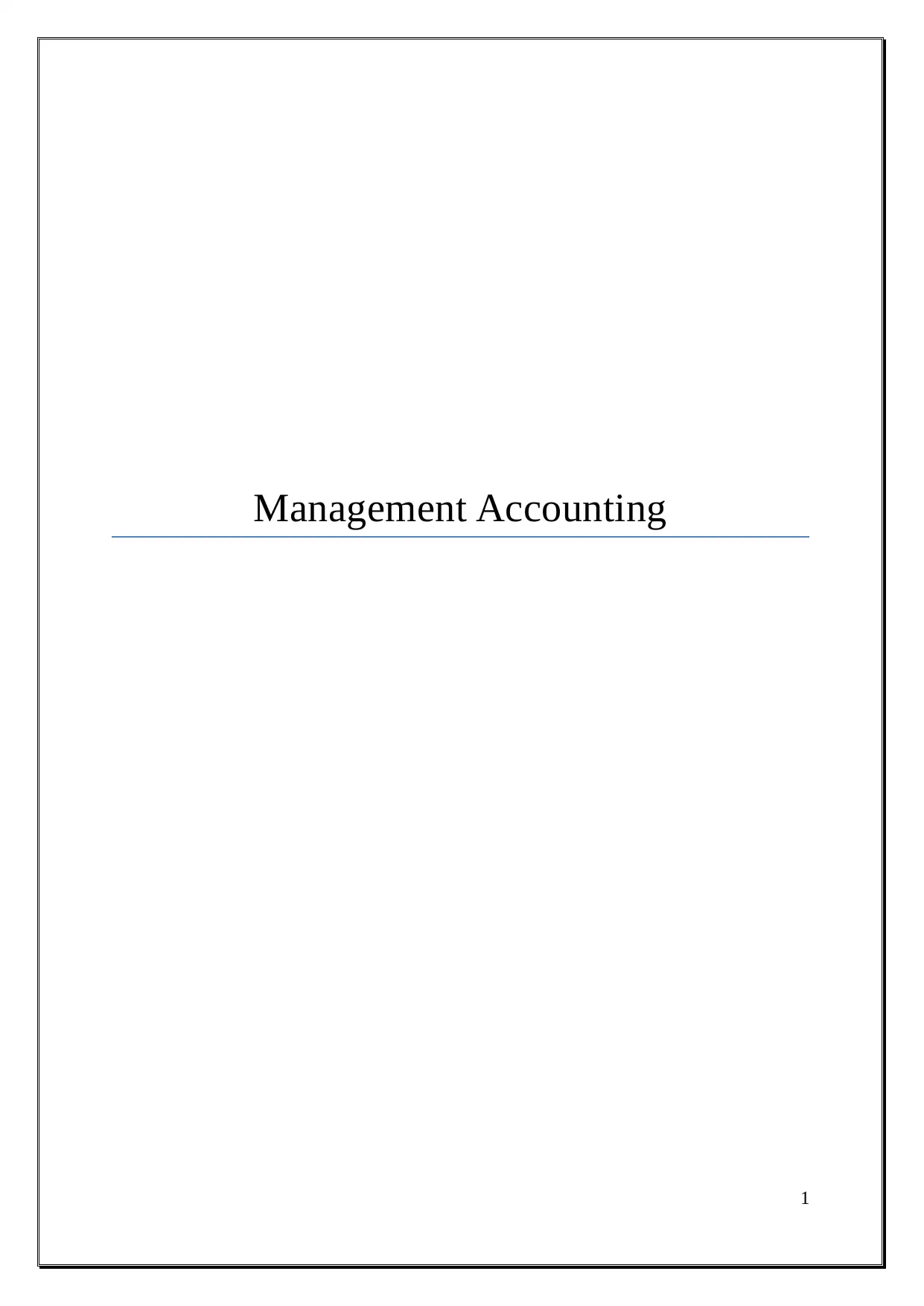
Management Accounting
1
1
Secure Best Marks with AI Grader
Need help grading? Try our AI Grader for instant feedback on your assignments.
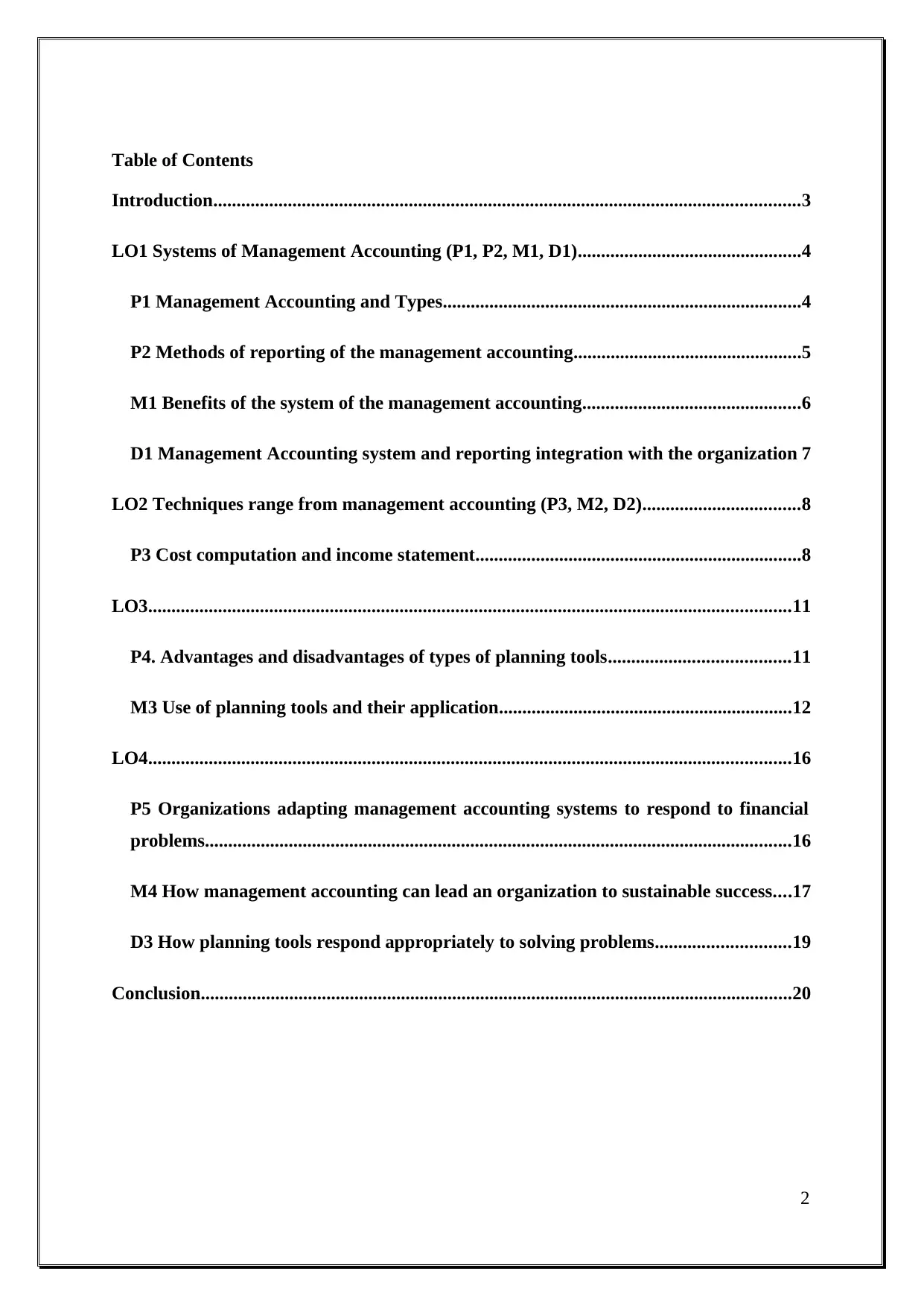
Table of Contents
Introduction..............................................................................................................................3
LO1 Systems of Management Accounting (P1, P2, M1, D1)................................................4
P1 Management Accounting and Types.............................................................................4
P2 Methods of reporting of the management accounting.................................................5
M1 Benefits of the system of the management accounting...............................................6
D1 Management Accounting system and reporting integration with the organization 7
LO2 Techniques range from management accounting (P3, M2, D2)..................................8
P3 Cost computation and income statement......................................................................8
LO3..........................................................................................................................................11
P4. Advantages and disadvantages of types of planning tools.......................................11
M3 Use of planning tools and their application...............................................................12
LO4..........................................................................................................................................16
P5 Organizations adapting management accounting systems to respond to financial
problems..............................................................................................................................16
M4 How management accounting can lead an organization to sustainable success....17
D3 How planning tools respond appropriately to solving problems.............................19
Conclusion...............................................................................................................................20
2
Introduction..............................................................................................................................3
LO1 Systems of Management Accounting (P1, P2, M1, D1)................................................4
P1 Management Accounting and Types.............................................................................4
P2 Methods of reporting of the management accounting.................................................5
M1 Benefits of the system of the management accounting...............................................6
D1 Management Accounting system and reporting integration with the organization 7
LO2 Techniques range from management accounting (P3, M2, D2)..................................8
P3 Cost computation and income statement......................................................................8
LO3..........................................................................................................................................11
P4. Advantages and disadvantages of types of planning tools.......................................11
M3 Use of planning tools and their application...............................................................12
LO4..........................................................................................................................................16
P5 Organizations adapting management accounting systems to respond to financial
problems..............................................................................................................................16
M4 How management accounting can lead an organization to sustainable success....17
D3 How planning tools respond appropriately to solving problems.............................19
Conclusion...............................................................................................................................20
2
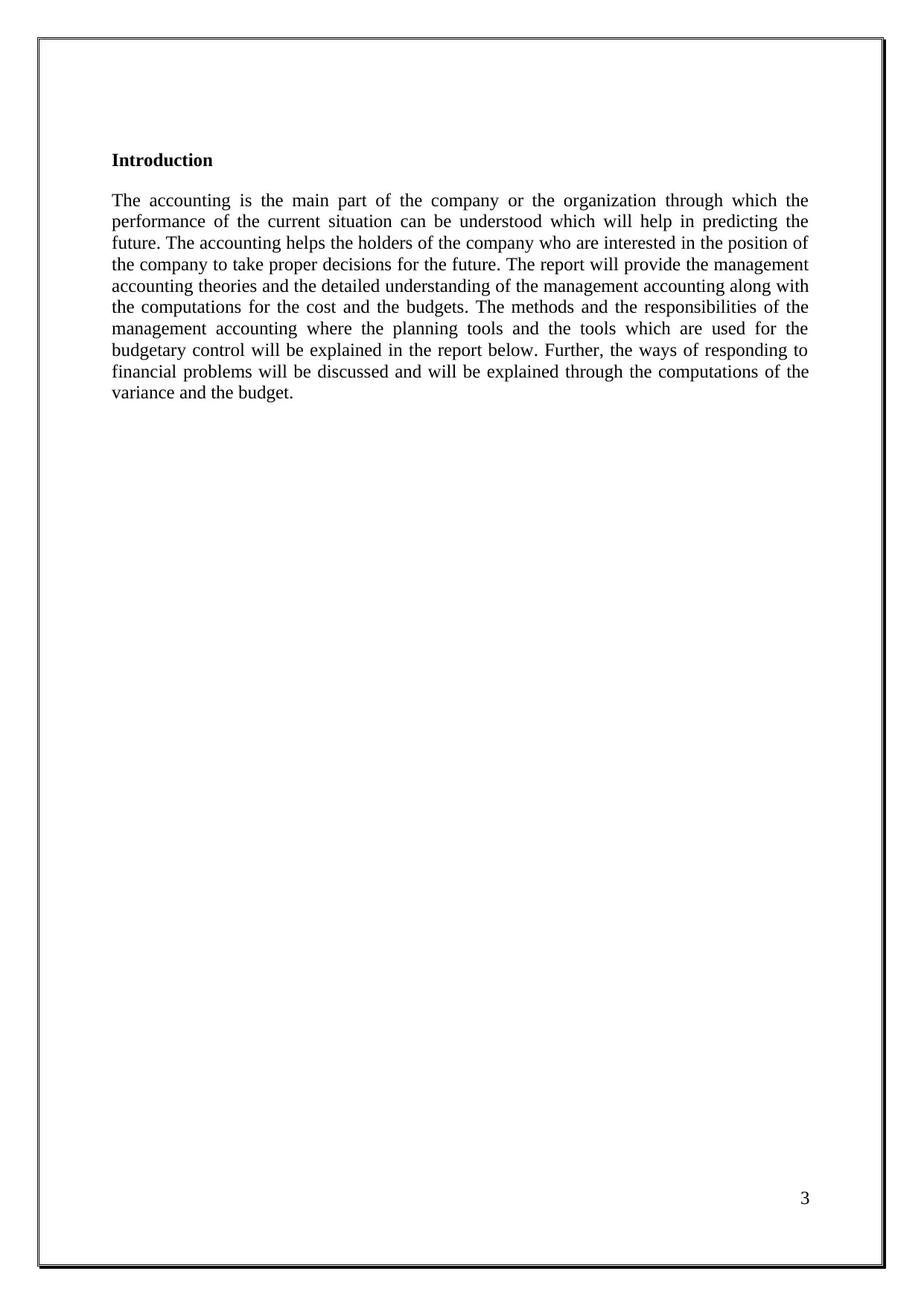
Introduction
The accounting is the main part of the company or the organization through which the
performance of the current situation can be understood which will help in predicting the
future. The accounting helps the holders of the company who are interested in the position of
the company to take proper decisions for the future. The report will provide the management
accounting theories and the detailed understanding of the management accounting along with
the computations for the cost and the budgets. The methods and the responsibilities of the
management accounting where the planning tools and the tools which are used for the
budgetary control will be explained in the report below. Further, the ways of responding to
financial problems will be discussed and will be explained through the computations of the
variance and the budget.
3
The accounting is the main part of the company or the organization through which the
performance of the current situation can be understood which will help in predicting the
future. The accounting helps the holders of the company who are interested in the position of
the company to take proper decisions for the future. The report will provide the management
accounting theories and the detailed understanding of the management accounting along with
the computations for the cost and the budgets. The methods and the responsibilities of the
management accounting where the planning tools and the tools which are used for the
budgetary control will be explained in the report below. Further, the ways of responding to
financial problems will be discussed and will be explained through the computations of the
variance and the budget.
3
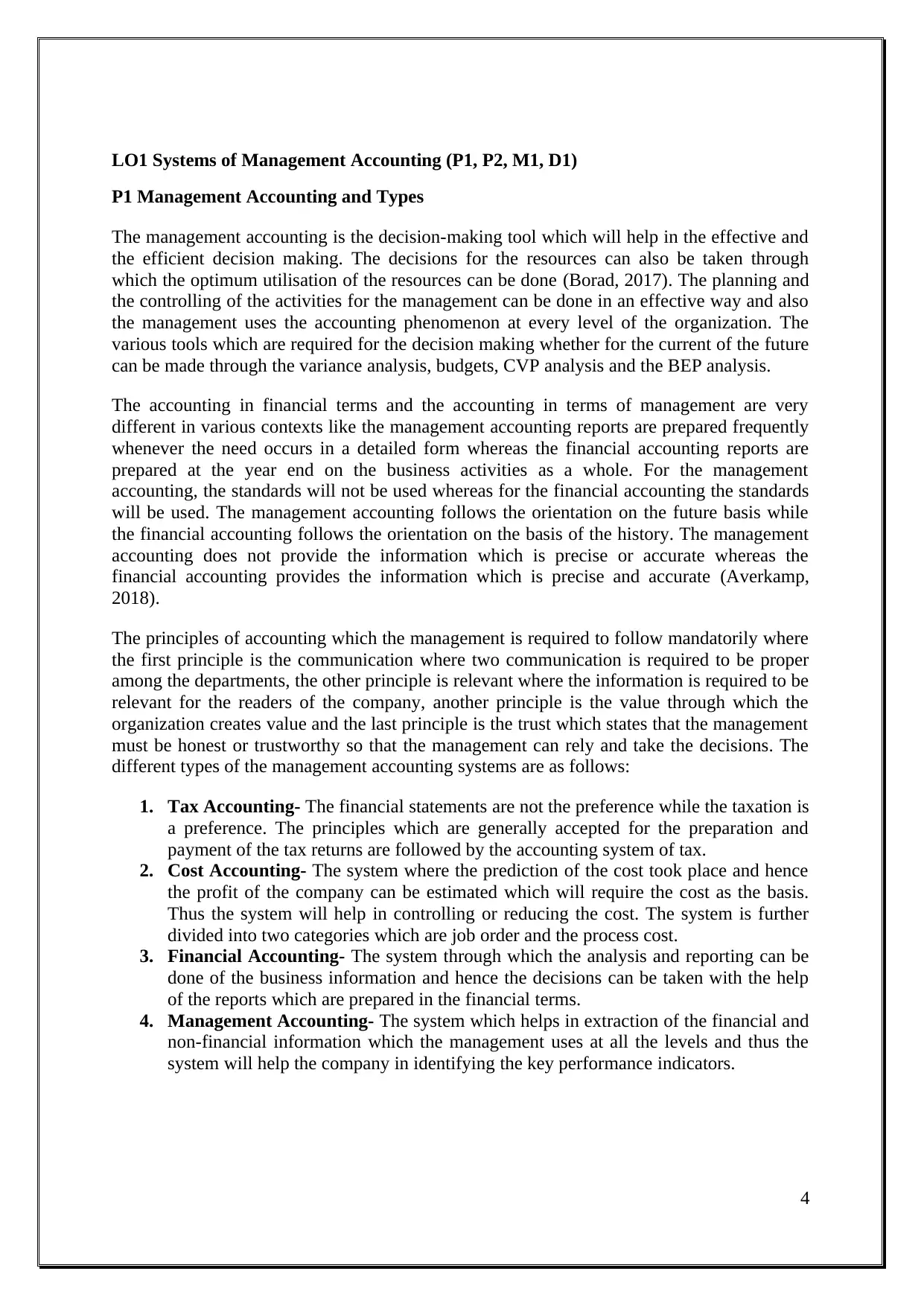
LO1 Systems of Management Accounting (P1, P2, M1, D1)
P1 Management Accounting and Types
The management accounting is the decision-making tool which will help in the effective and
the efficient decision making. The decisions for the resources can also be taken through
which the optimum utilisation of the resources can be done (Borad, 2017). The planning and
the controlling of the activities for the management can be done in an effective way and also
the management uses the accounting phenomenon at every level of the organization. The
various tools which are required for the decision making whether for the current of the future
can be made through the variance analysis, budgets, CVP analysis and the BEP analysis.
The accounting in financial terms and the accounting in terms of management are very
different in various contexts like the management accounting reports are prepared frequently
whenever the need occurs in a detailed form whereas the financial accounting reports are
prepared at the year end on the business activities as a whole. For the management
accounting, the standards will not be used whereas for the financial accounting the standards
will be used. The management accounting follows the orientation on the future basis while
the financial accounting follows the orientation on the basis of the history. The management
accounting does not provide the information which is precise or accurate whereas the
financial accounting provides the information which is precise and accurate (Averkamp,
2018).
The principles of accounting which the management is required to follow mandatorily where
the first principle is the communication where two communication is required to be proper
among the departments, the other principle is relevant where the information is required to be
relevant for the readers of the company, another principle is the value through which the
organization creates value and the last principle is the trust which states that the management
must be honest or trustworthy so that the management can rely and take the decisions. The
different types of the management accounting systems are as follows:
1. Tax Accounting- The financial statements are not the preference while the taxation is
a preference. The principles which are generally accepted for the preparation and
payment of the tax returns are followed by the accounting system of tax.
2. Cost Accounting- The system where the prediction of the cost took place and hence
the profit of the company can be estimated which will require the cost as the basis.
Thus the system will help in controlling or reducing the cost. The system is further
divided into two categories which are job order and the process cost.
3. Financial Accounting- The system through which the analysis and reporting can be
done of the business information and hence the decisions can be taken with the help
of the reports which are prepared in the financial terms.
4. Management Accounting- The system which helps in extraction of the financial and
non-financial information which the management uses at all the levels and thus the
system will help the company in identifying the key performance indicators.
4
P1 Management Accounting and Types
The management accounting is the decision-making tool which will help in the effective and
the efficient decision making. The decisions for the resources can also be taken through
which the optimum utilisation of the resources can be done (Borad, 2017). The planning and
the controlling of the activities for the management can be done in an effective way and also
the management uses the accounting phenomenon at every level of the organization. The
various tools which are required for the decision making whether for the current of the future
can be made through the variance analysis, budgets, CVP analysis and the BEP analysis.
The accounting in financial terms and the accounting in terms of management are very
different in various contexts like the management accounting reports are prepared frequently
whenever the need occurs in a detailed form whereas the financial accounting reports are
prepared at the year end on the business activities as a whole. For the management
accounting, the standards will not be used whereas for the financial accounting the standards
will be used. The management accounting follows the orientation on the future basis while
the financial accounting follows the orientation on the basis of the history. The management
accounting does not provide the information which is precise or accurate whereas the
financial accounting provides the information which is precise and accurate (Averkamp,
2018).
The principles of accounting which the management is required to follow mandatorily where
the first principle is the communication where two communication is required to be proper
among the departments, the other principle is relevant where the information is required to be
relevant for the readers of the company, another principle is the value through which the
organization creates value and the last principle is the trust which states that the management
must be honest or trustworthy so that the management can rely and take the decisions. The
different types of the management accounting systems are as follows:
1. Tax Accounting- The financial statements are not the preference while the taxation is
a preference. The principles which are generally accepted for the preparation and
payment of the tax returns are followed by the accounting system of tax.
2. Cost Accounting- The system where the prediction of the cost took place and hence
the profit of the company can be estimated which will require the cost as the basis.
Thus the system will help in controlling or reducing the cost. The system is further
divided into two categories which are job order and the process cost.
3. Financial Accounting- The system through which the analysis and reporting can be
done of the business information and hence the decisions can be taken with the help
of the reports which are prepared in the financial terms.
4. Management Accounting- The system which helps in extraction of the financial and
non-financial information which the management uses at all the levels and thus the
system will help the company in identifying the key performance indicators.
4
Secure Best Marks with AI Grader
Need help grading? Try our AI Grader for instant feedback on your assignments.
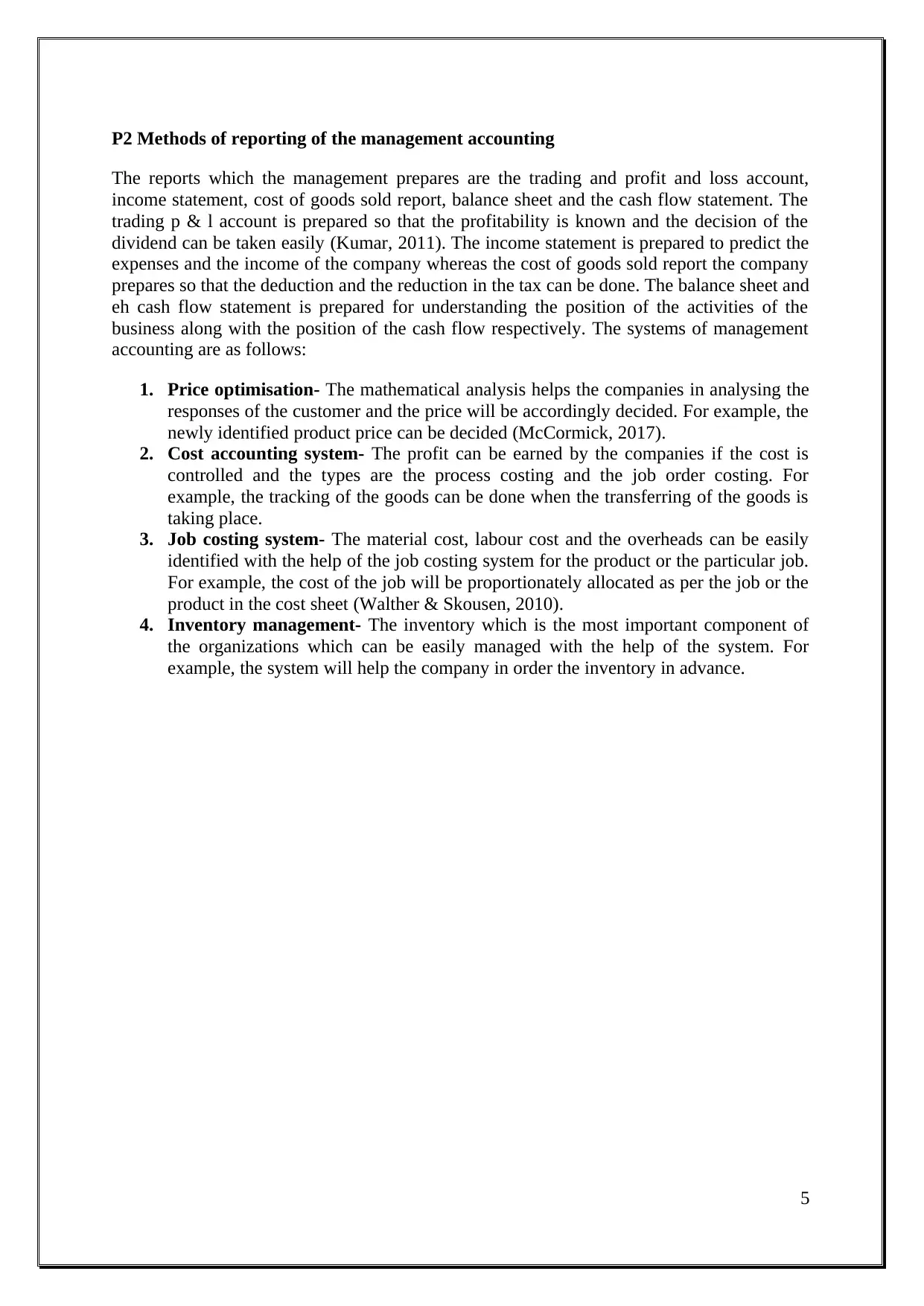
P2 Methods of reporting of the management accounting
The reports which the management prepares are the trading and profit and loss account,
income statement, cost of goods sold report, balance sheet and the cash flow statement. The
trading p & l account is prepared so that the profitability is known and the decision of the
dividend can be taken easily (Kumar, 2011). The income statement is prepared to predict the
expenses and the income of the company whereas the cost of goods sold report the company
prepares so that the deduction and the reduction in the tax can be done. The balance sheet and
eh cash flow statement is prepared for understanding the position of the activities of the
business along with the position of the cash flow respectively. The systems of management
accounting are as follows:
1. Price optimisation- The mathematical analysis helps the companies in analysing the
responses of the customer and the price will be accordingly decided. For example, the
newly identified product price can be decided (McCormick, 2017).
2. Cost accounting system- The profit can be earned by the companies if the cost is
controlled and the types are the process costing and the job order costing. For
example, the tracking of the goods can be done when the transferring of the goods is
taking place.
3. Job costing system- The material cost, labour cost and the overheads can be easily
identified with the help of the job costing system for the product or the particular job.
For example, the cost of the job will be proportionately allocated as per the job or the
product in the cost sheet (Walther & Skousen, 2010).
4. Inventory management- The inventory which is the most important component of
the organizations which can be easily managed with the help of the system. For
example, the system will help the company in order the inventory in advance.
5
The reports which the management prepares are the trading and profit and loss account,
income statement, cost of goods sold report, balance sheet and the cash flow statement. The
trading p & l account is prepared so that the profitability is known and the decision of the
dividend can be taken easily (Kumar, 2011). The income statement is prepared to predict the
expenses and the income of the company whereas the cost of goods sold report the company
prepares so that the deduction and the reduction in the tax can be done. The balance sheet and
eh cash flow statement is prepared for understanding the position of the activities of the
business along with the position of the cash flow respectively. The systems of management
accounting are as follows:
1. Price optimisation- The mathematical analysis helps the companies in analysing the
responses of the customer and the price will be accordingly decided. For example, the
newly identified product price can be decided (McCormick, 2017).
2. Cost accounting system- The profit can be earned by the companies if the cost is
controlled and the types are the process costing and the job order costing. For
example, the tracking of the goods can be done when the transferring of the goods is
taking place.
3. Job costing system- The material cost, labour cost and the overheads can be easily
identified with the help of the job costing system for the product or the particular job.
For example, the cost of the job will be proportionately allocated as per the job or the
product in the cost sheet (Walther & Skousen, 2010).
4. Inventory management- The inventory which is the most important component of
the organizations which can be easily managed with the help of the system. For
example, the system will help the company in order the inventory in advance.
5
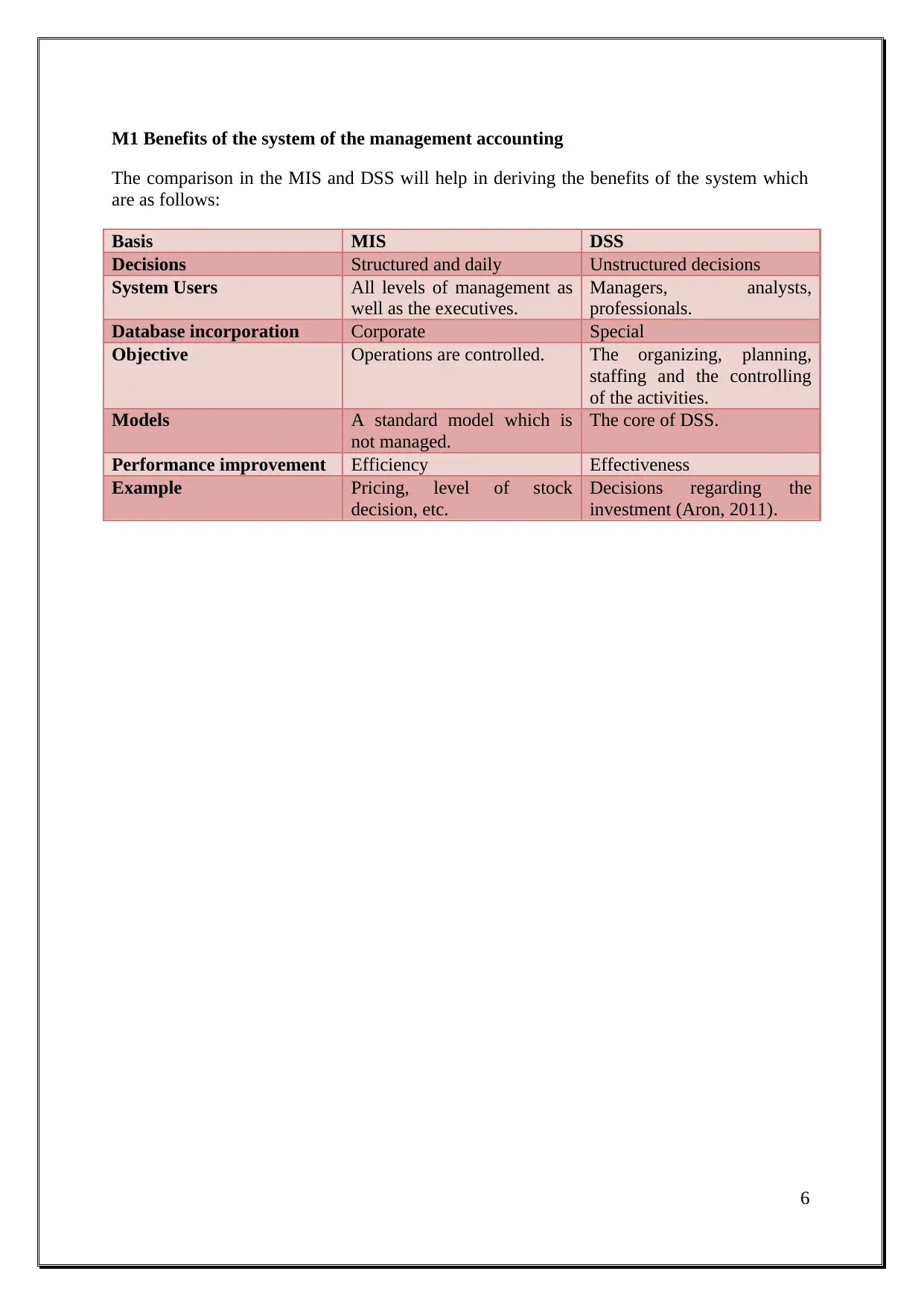
M1 Benefits of the system of the management accounting
The comparison in the MIS and DSS will help in deriving the benefits of the system which
are as follows:
Basis MIS DSS
Decisions Structured and daily Unstructured decisions
System Users All levels of management as
well as the executives.
Managers, analysts,
professionals.
Database incorporation Corporate Special
Objective Operations are controlled. The organizing, planning,
staffing and the controlling
of the activities.
Models A standard model which is
not managed.
The core of DSS.
Performance improvement Efficiency Effectiveness
Example Pricing, level of stock
decision, etc.
Decisions regarding the
investment (Aron, 2011).
6
The comparison in the MIS and DSS will help in deriving the benefits of the system which
are as follows:
Basis MIS DSS
Decisions Structured and daily Unstructured decisions
System Users All levels of management as
well as the executives.
Managers, analysts,
professionals.
Database incorporation Corporate Special
Objective Operations are controlled. The organizing, planning,
staffing and the controlling
of the activities.
Models A standard model which is
not managed.
The core of DSS.
Performance improvement Efficiency Effectiveness
Example Pricing, level of stock
decision, etc.
Decisions regarding the
investment (Aron, 2011).
6
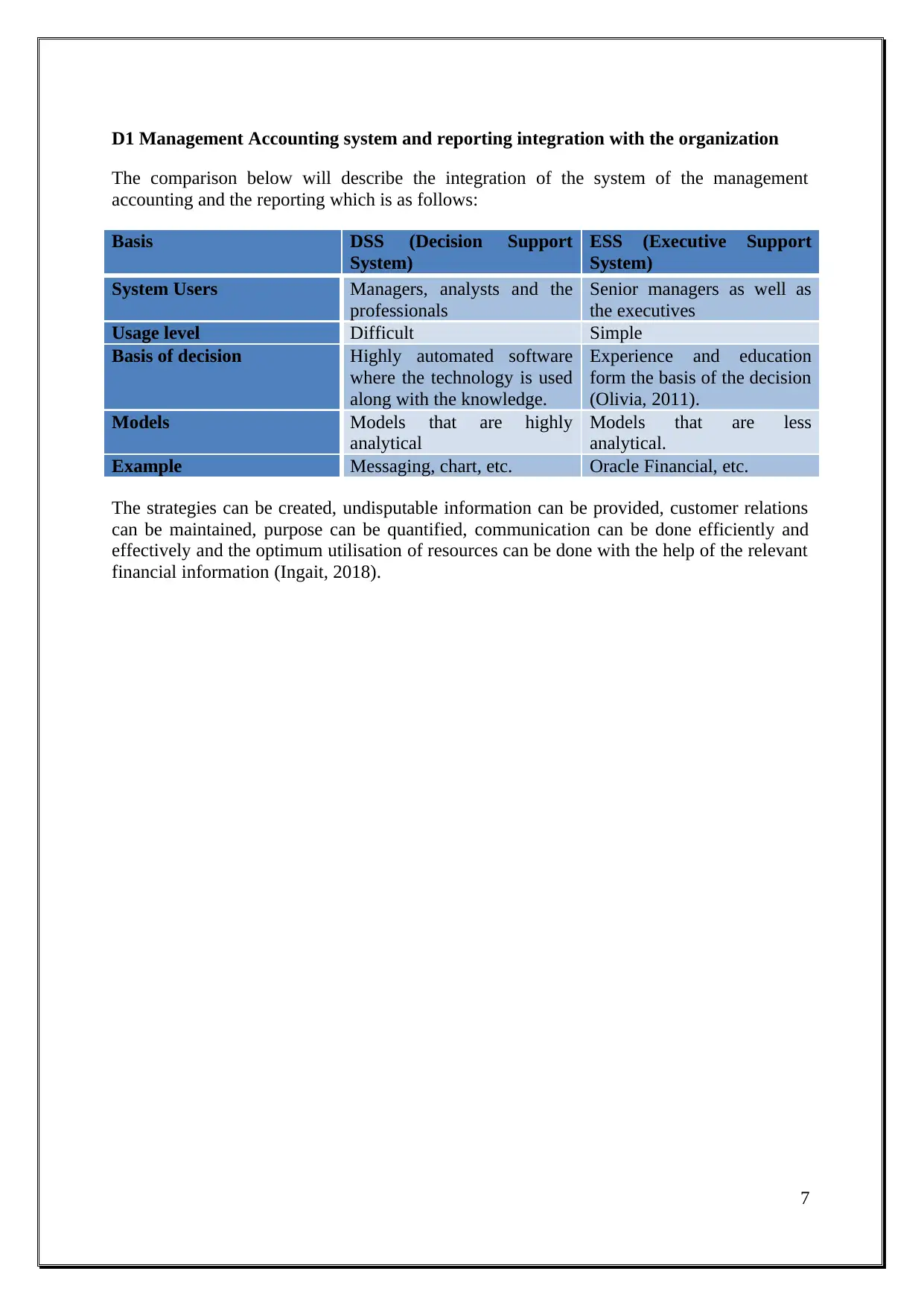
D1 Management Accounting system and reporting integration with the organization
The comparison below will describe the integration of the system of the management
accounting and the reporting which is as follows:
Basis DSS (Decision Support
System)
ESS (Executive Support
System)
System Users Managers, analysts and the
professionals
Senior managers as well as
the executives
Usage level Difficult Simple
Basis of decision Highly automated software
where the technology is used
along with the knowledge.
Experience and education
form the basis of the decision
(Olivia, 2011).
Models Models that are highly
analytical
Models that are less
analytical.
Example Messaging, chart, etc. Oracle Financial, etc.
The strategies can be created, undisputable information can be provided, customer relations
can be maintained, purpose can be quantified, communication can be done efficiently and
effectively and the optimum utilisation of resources can be done with the help of the relevant
financial information (Ingait, 2018).
7
The comparison below will describe the integration of the system of the management
accounting and the reporting which is as follows:
Basis DSS (Decision Support
System)
ESS (Executive Support
System)
System Users Managers, analysts and the
professionals
Senior managers as well as
the executives
Usage level Difficult Simple
Basis of decision Highly automated software
where the technology is used
along with the knowledge.
Experience and education
form the basis of the decision
(Olivia, 2011).
Models Models that are highly
analytical
Models that are less
analytical.
Example Messaging, chart, etc. Oracle Financial, etc.
The strategies can be created, undisputable information can be provided, customer relations
can be maintained, purpose can be quantified, communication can be done efficiently and
effectively and the optimum utilisation of resources can be done with the help of the relevant
financial information (Ingait, 2018).
7
Paraphrase This Document
Need a fresh take? Get an instant paraphrase of this document with our AI Paraphraser
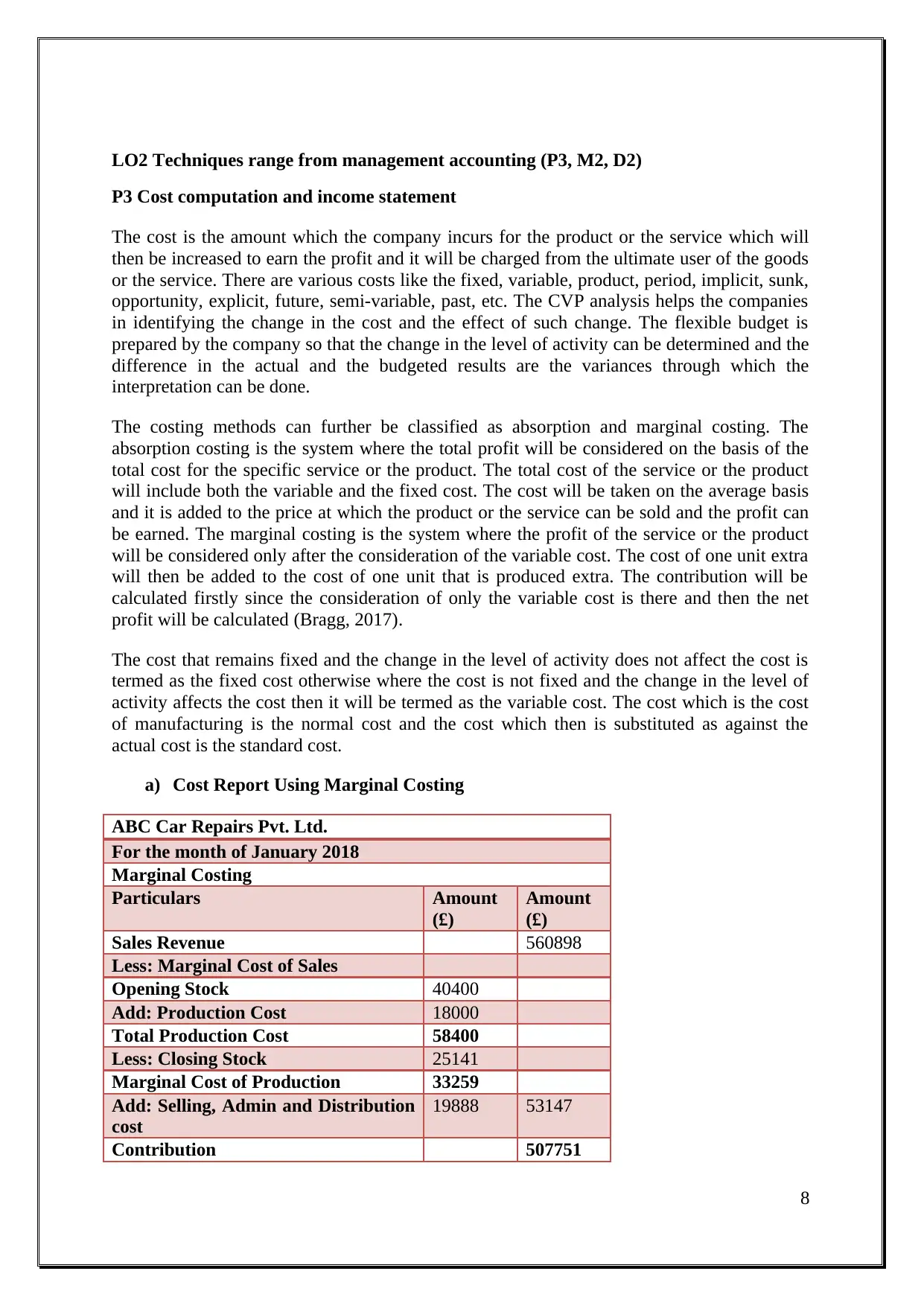
LO2 Techniques range from management accounting (P3, M2, D2)
P3 Cost computation and income statement
The cost is the amount which the company incurs for the product or the service which will
then be increased to earn the profit and it will be charged from the ultimate user of the goods
or the service. There are various costs like the fixed, variable, product, period, implicit, sunk,
opportunity, explicit, future, semi-variable, past, etc. The CVP analysis helps the companies
in identifying the change in the cost and the effect of such change. The flexible budget is
prepared by the company so that the change in the level of activity can be determined and the
difference in the actual and the budgeted results are the variances through which the
interpretation can be done.
The costing methods can further be classified as absorption and marginal costing. The
absorption costing is the system where the total profit will be considered on the basis of the
total cost for the specific service or the product. The total cost of the service or the product
will include both the variable and the fixed cost. The cost will be taken on the average basis
and it is added to the price at which the product or the service can be sold and the profit can
be earned. The marginal costing is the system where the profit of the service or the product
will be considered only after the consideration of the variable cost. The cost of one unit extra
will then be added to the cost of one unit that is produced extra. The contribution will be
calculated firstly since the consideration of only the variable cost is there and then the net
profit will be calculated (Bragg, 2017).
The cost that remains fixed and the change in the level of activity does not affect the cost is
termed as the fixed cost otherwise where the cost is not fixed and the change in the level of
activity affects the cost then it will be termed as the variable cost. The cost which is the cost
of manufacturing is the normal cost and the cost which then is substituted as against the
actual cost is the standard cost.
a) Cost Report Using Marginal Costing
ABC Car Repairs Pvt. Ltd.
For the month of January 2018
Marginal Costing
Particulars Amount
(£)
Amount
(£)
Sales Revenue 560898
Less: Marginal Cost of Sales
Opening Stock 40400
Add: Production Cost 18000
Total Production Cost 58400
Less: Closing Stock 25141
Marginal Cost of Production 33259
Add: Selling, Admin and Distribution
cost
19888 53147
Contribution 507751
8
P3 Cost computation and income statement
The cost is the amount which the company incurs for the product or the service which will
then be increased to earn the profit and it will be charged from the ultimate user of the goods
or the service. There are various costs like the fixed, variable, product, period, implicit, sunk,
opportunity, explicit, future, semi-variable, past, etc. The CVP analysis helps the companies
in identifying the change in the cost and the effect of such change. The flexible budget is
prepared by the company so that the change in the level of activity can be determined and the
difference in the actual and the budgeted results are the variances through which the
interpretation can be done.
The costing methods can further be classified as absorption and marginal costing. The
absorption costing is the system where the total profit will be considered on the basis of the
total cost for the specific service or the product. The total cost of the service or the product
will include both the variable and the fixed cost. The cost will be taken on the average basis
and it is added to the price at which the product or the service can be sold and the profit can
be earned. The marginal costing is the system where the profit of the service or the product
will be considered only after the consideration of the variable cost. The cost of one unit extra
will then be added to the cost of one unit that is produced extra. The contribution will be
calculated firstly since the consideration of only the variable cost is there and then the net
profit will be calculated (Bragg, 2017).
The cost that remains fixed and the change in the level of activity does not affect the cost is
termed as the fixed cost otherwise where the cost is not fixed and the change in the level of
activity affects the cost then it will be termed as the variable cost. The cost which is the cost
of manufacturing is the normal cost and the cost which then is substituted as against the
actual cost is the standard cost.
a) Cost Report Using Marginal Costing
ABC Car Repairs Pvt. Ltd.
For the month of January 2018
Marginal Costing
Particulars Amount
(£)
Amount
(£)
Sales Revenue 560898
Less: Marginal Cost of Sales
Opening Stock 40400
Add: Production Cost 18000
Total Production Cost 58400
Less: Closing Stock 25141
Marginal Cost of Production 33259
Add: Selling, Admin and Distribution
cost
19888 53147
Contribution 507751
8
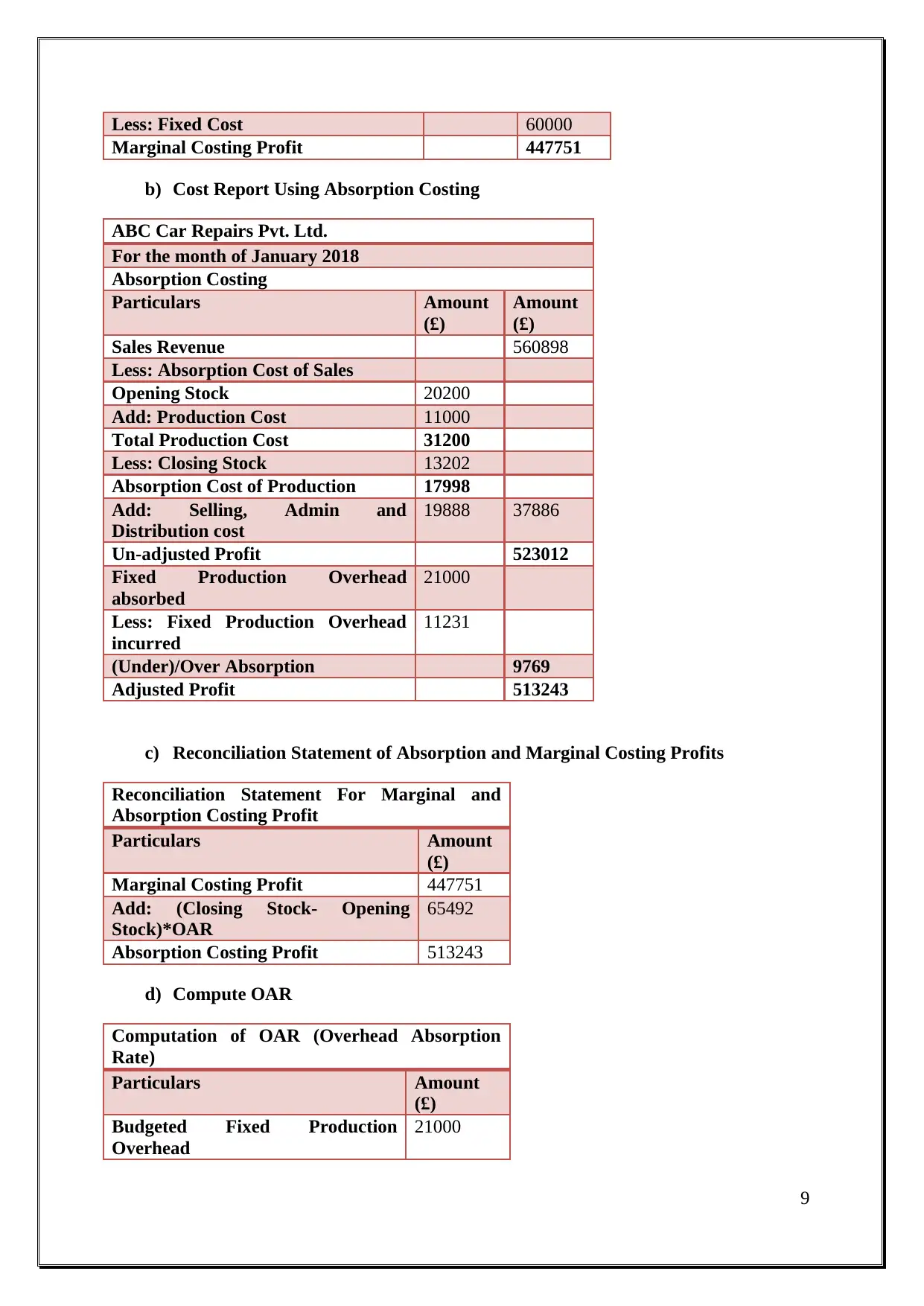
Less: Fixed Cost 60000
Marginal Costing Profit 447751
b) Cost Report Using Absorption Costing
ABC Car Repairs Pvt. Ltd.
For the month of January 2018
Absorption Costing
Particulars Amount
(£)
Amount
(£)
Sales Revenue 560898
Less: Absorption Cost of Sales
Opening Stock 20200
Add: Production Cost 11000
Total Production Cost 31200
Less: Closing Stock 13202
Absorption Cost of Production 17998
Add: Selling, Admin and
Distribution cost
19888 37886
Un-adjusted Profit 523012
Fixed Production Overhead
absorbed
21000
Less: Fixed Production Overhead
incurred
11231
(Under)/Over Absorption 9769
Adjusted Profit 513243
c) Reconciliation Statement of Absorption and Marginal Costing Profits
Reconciliation Statement For Marginal and
Absorption Costing Profit
Particulars Amount
(£)
Marginal Costing Profit 447751
Add: (Closing Stock- Opening
Stock)*OAR
65492
Absorption Costing Profit 513243
d) Compute OAR
Computation of OAR (Overhead Absorption
Rate)
Particulars Amount
(£)
Budgeted Fixed Production
Overhead
21000
9
Marginal Costing Profit 447751
b) Cost Report Using Absorption Costing
ABC Car Repairs Pvt. Ltd.
For the month of January 2018
Absorption Costing
Particulars Amount
(£)
Amount
(£)
Sales Revenue 560898
Less: Absorption Cost of Sales
Opening Stock 20200
Add: Production Cost 11000
Total Production Cost 31200
Less: Closing Stock 13202
Absorption Cost of Production 17998
Add: Selling, Admin and
Distribution cost
19888 37886
Un-adjusted Profit 523012
Fixed Production Overhead
absorbed
21000
Less: Fixed Production Overhead
incurred
11231
(Under)/Over Absorption 9769
Adjusted Profit 513243
c) Reconciliation Statement of Absorption and Marginal Costing Profits
Reconciliation Statement For Marginal and
Absorption Costing Profit
Particulars Amount
(£)
Marginal Costing Profit 447751
Add: (Closing Stock- Opening
Stock)*OAR
65492
Absorption Costing Profit 513243
d) Compute OAR
Computation of OAR (Overhead Absorption
Rate)
Particulars Amount
(£)
Budgeted Fixed Production
Overhead
21000
9
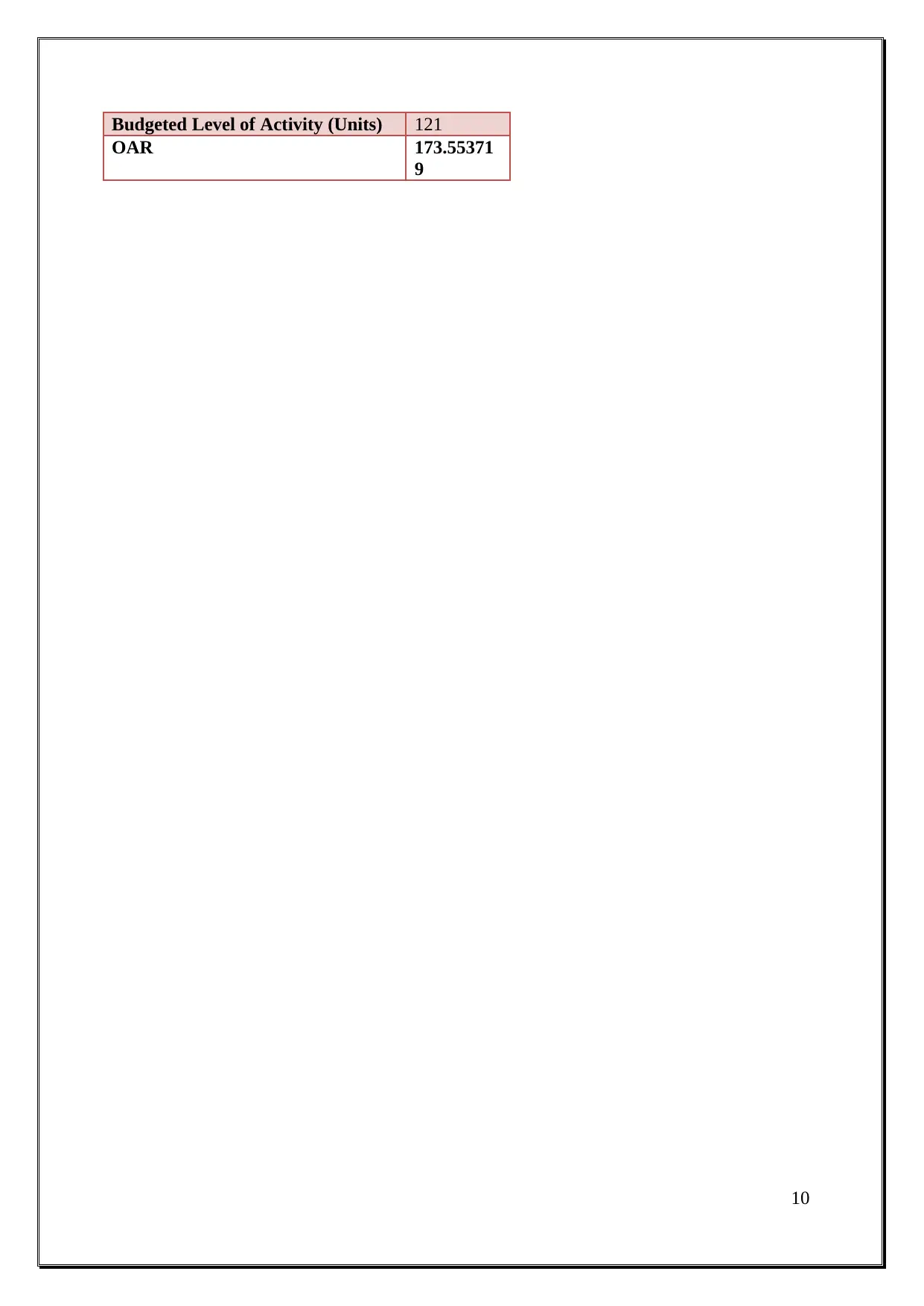
Budgeted Level of Activity (Units) 121
OAR 173.55371
9
10
OAR 173.55371
9
10
Secure Best Marks with AI Grader
Need help grading? Try our AI Grader for instant feedback on your assignments.
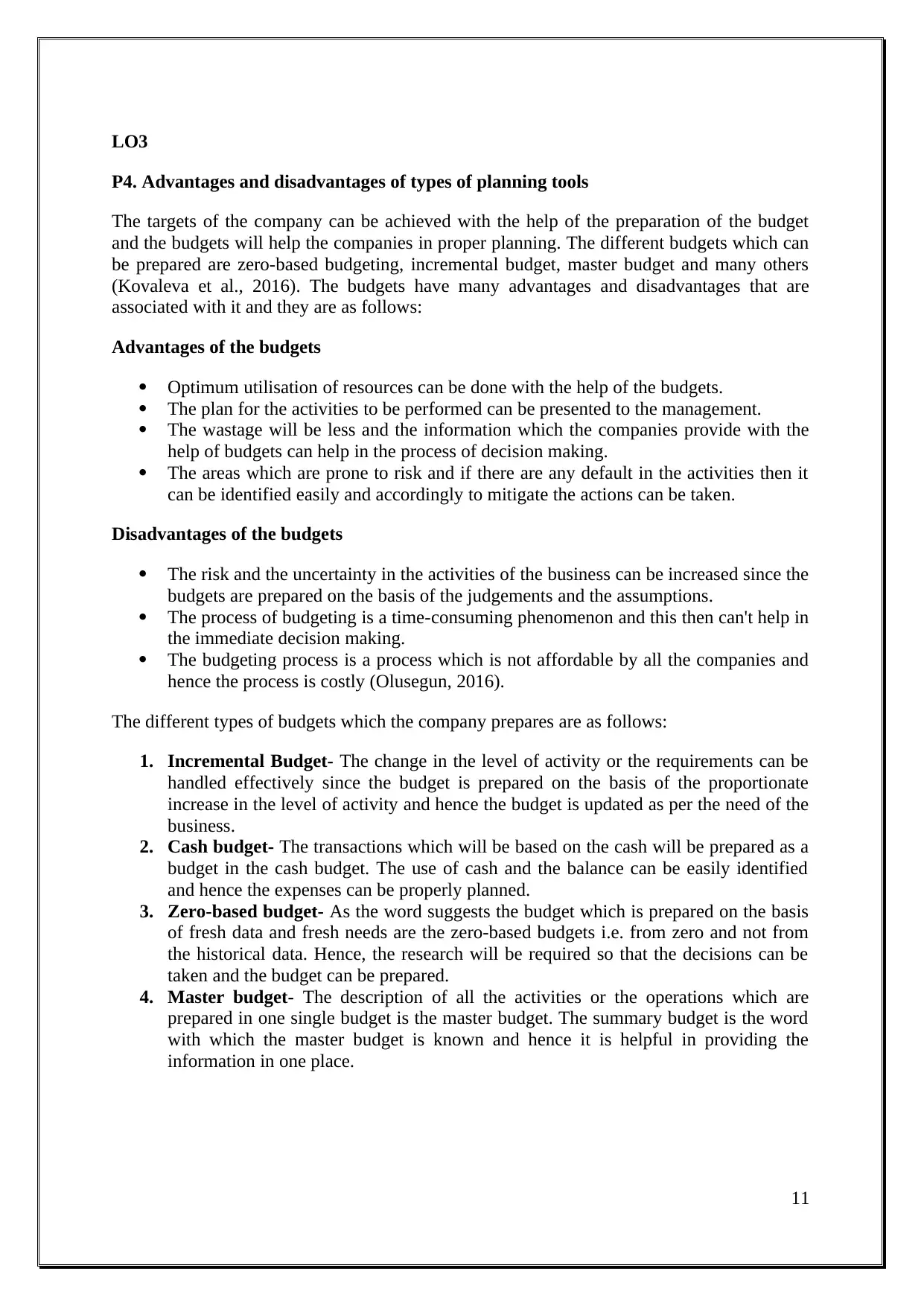
LO3
P4. Advantages and disadvantages of types of planning tools
The targets of the company can be achieved with the help of the preparation of the budget
and the budgets will help the companies in proper planning. The different budgets which can
be prepared are zero-based budgeting, incremental budget, master budget and many others
(Kovaleva et al., 2016). The budgets have many advantages and disadvantages that are
associated with it and they are as follows:
Advantages of the budgets
Optimum utilisation of resources can be done with the help of the budgets.
The plan for the activities to be performed can be presented to the management.
The wastage will be less and the information which the companies provide with the
help of budgets can help in the process of decision making.
The areas which are prone to risk and if there are any default in the activities then it
can be identified easily and accordingly to mitigate the actions can be taken.
Disadvantages of the budgets
The risk and the uncertainty in the activities of the business can be increased since the
budgets are prepared on the basis of the judgements and the assumptions.
The process of budgeting is a time-consuming phenomenon and this then can't help in
the immediate decision making.
The budgeting process is a process which is not affordable by all the companies and
hence the process is costly (Olusegun, 2016).
The different types of budgets which the company prepares are as follows:
1. Incremental Budget- The change in the level of activity or the requirements can be
handled effectively since the budget is prepared on the basis of the proportionate
increase in the level of activity and hence the budget is updated as per the need of the
business.
2. Cash budget- The transactions which will be based on the cash will be prepared as a
budget in the cash budget. The use of cash and the balance can be easily identified
and hence the expenses can be properly planned.
3. Zero-based budget- As the word suggests the budget which is prepared on the basis
of fresh data and fresh needs are the zero-based budgets i.e. from zero and not from
the historical data. Hence, the research will be required so that the decisions can be
taken and the budget can be prepared.
4. Master budget- The description of all the activities or the operations which are
prepared in one single budget is the master budget. The summary budget is the word
with which the master budget is known and hence it is helpful in providing the
information in one place.
11
P4. Advantages and disadvantages of types of planning tools
The targets of the company can be achieved with the help of the preparation of the budget
and the budgets will help the companies in proper planning. The different budgets which can
be prepared are zero-based budgeting, incremental budget, master budget and many others
(Kovaleva et al., 2016). The budgets have many advantages and disadvantages that are
associated with it and they are as follows:
Advantages of the budgets
Optimum utilisation of resources can be done with the help of the budgets.
The plan for the activities to be performed can be presented to the management.
The wastage will be less and the information which the companies provide with the
help of budgets can help in the process of decision making.
The areas which are prone to risk and if there are any default in the activities then it
can be identified easily and accordingly to mitigate the actions can be taken.
Disadvantages of the budgets
The risk and the uncertainty in the activities of the business can be increased since the
budgets are prepared on the basis of the judgements and the assumptions.
The process of budgeting is a time-consuming phenomenon and this then can't help in
the immediate decision making.
The budgeting process is a process which is not affordable by all the companies and
hence the process is costly (Olusegun, 2016).
The different types of budgets which the company prepares are as follows:
1. Incremental Budget- The change in the level of activity or the requirements can be
handled effectively since the budget is prepared on the basis of the proportionate
increase in the level of activity and hence the budget is updated as per the need of the
business.
2. Cash budget- The transactions which will be based on the cash will be prepared as a
budget in the cash budget. The use of cash and the balance can be easily identified
and hence the expenses can be properly planned.
3. Zero-based budget- As the word suggests the budget which is prepared on the basis
of fresh data and fresh needs are the zero-based budgets i.e. from zero and not from
the historical data. Hence, the research will be required so that the decisions can be
taken and the budget can be prepared.
4. Master budget- The description of all the activities or the operations which are
prepared in one single budget is the master budget. The summary budget is the word
with which the master budget is known and hence it is helpful in providing the
information in one place.
11
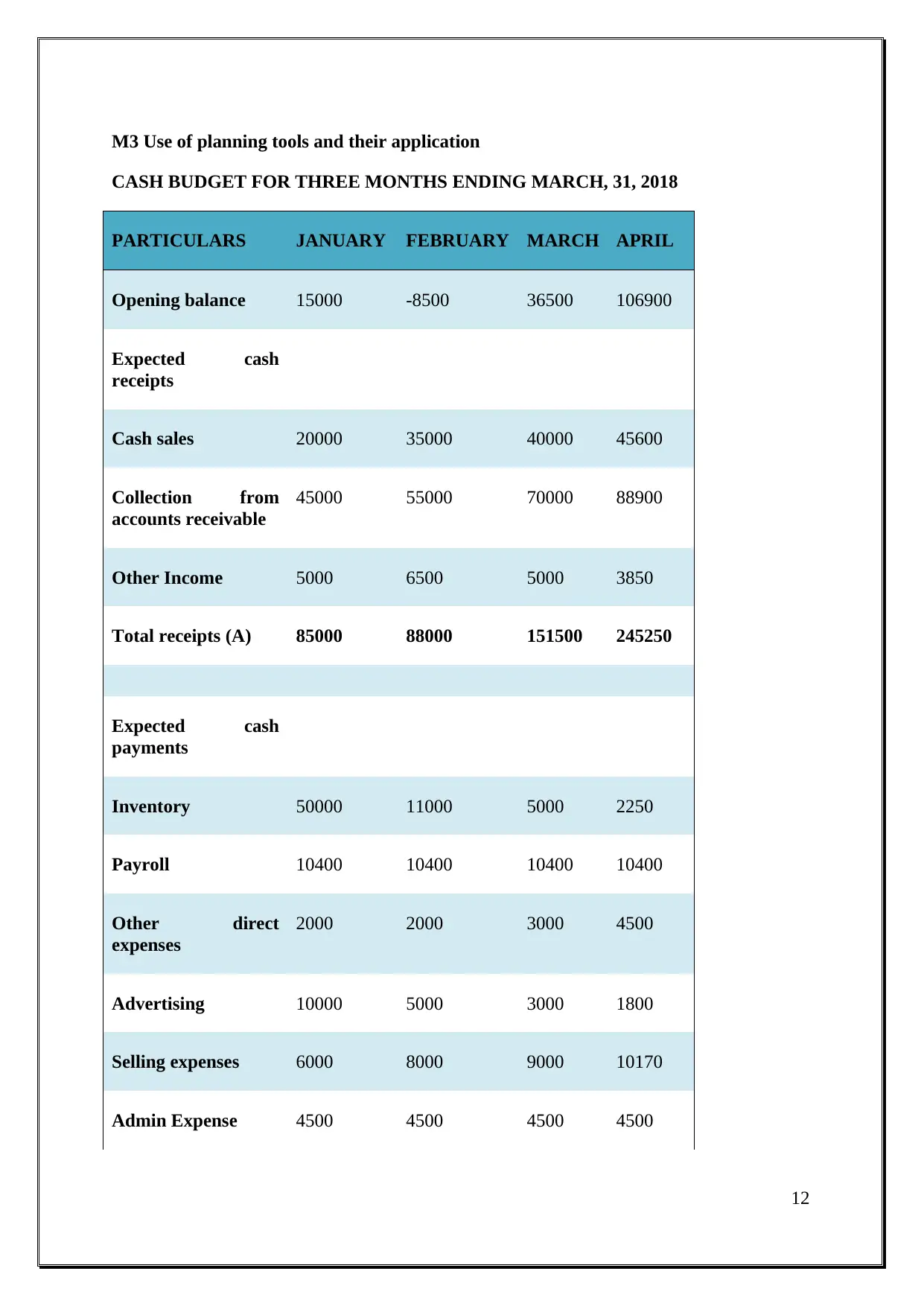
M3 Use of planning tools and their application
CASH BUDGET FOR THREE MONTHS ENDING MARCH, 31, 2018
PARTICULARS JANUARY FEBRUARY MARCH APRIL
Opening balance 15000 -8500 36500 106900
Expected cash
receipts
Cash sales 20000 35000 40000 45600
Collection from
accounts receivable
45000 55000 70000 88900
Other Income 5000 6500 5000 3850
Total receipts (A) 85000 88000 151500 245250
Expected cash
payments
Inventory 50000 11000 5000 2250
Payroll 10400 10400 10400 10400
Other direct
expenses
2000 2000 3000 4500
Advertising 10000 5000 3000 1800
Selling expenses 6000 8000 9000 10170
Admin Expense 4500 4500 4500 4500
12
CASH BUDGET FOR THREE MONTHS ENDING MARCH, 31, 2018
PARTICULARS JANUARY FEBRUARY MARCH APRIL
Opening balance 15000 -8500 36500 106900
Expected cash
receipts
Cash sales 20000 35000 40000 45600
Collection from
accounts receivable
45000 55000 70000 88900
Other Income 5000 6500 5000 3850
Total receipts (A) 85000 88000 151500 245250
Expected cash
payments
Inventory 50000 11000 5000 2250
Payroll 10400 10400 10400 10400
Other direct
expenses
2000 2000 3000 4500
Advertising 10000 5000 3000 1800
Selling expenses 6000 8000 9000 10170
Admin Expense 4500 4500 4500 4500
12
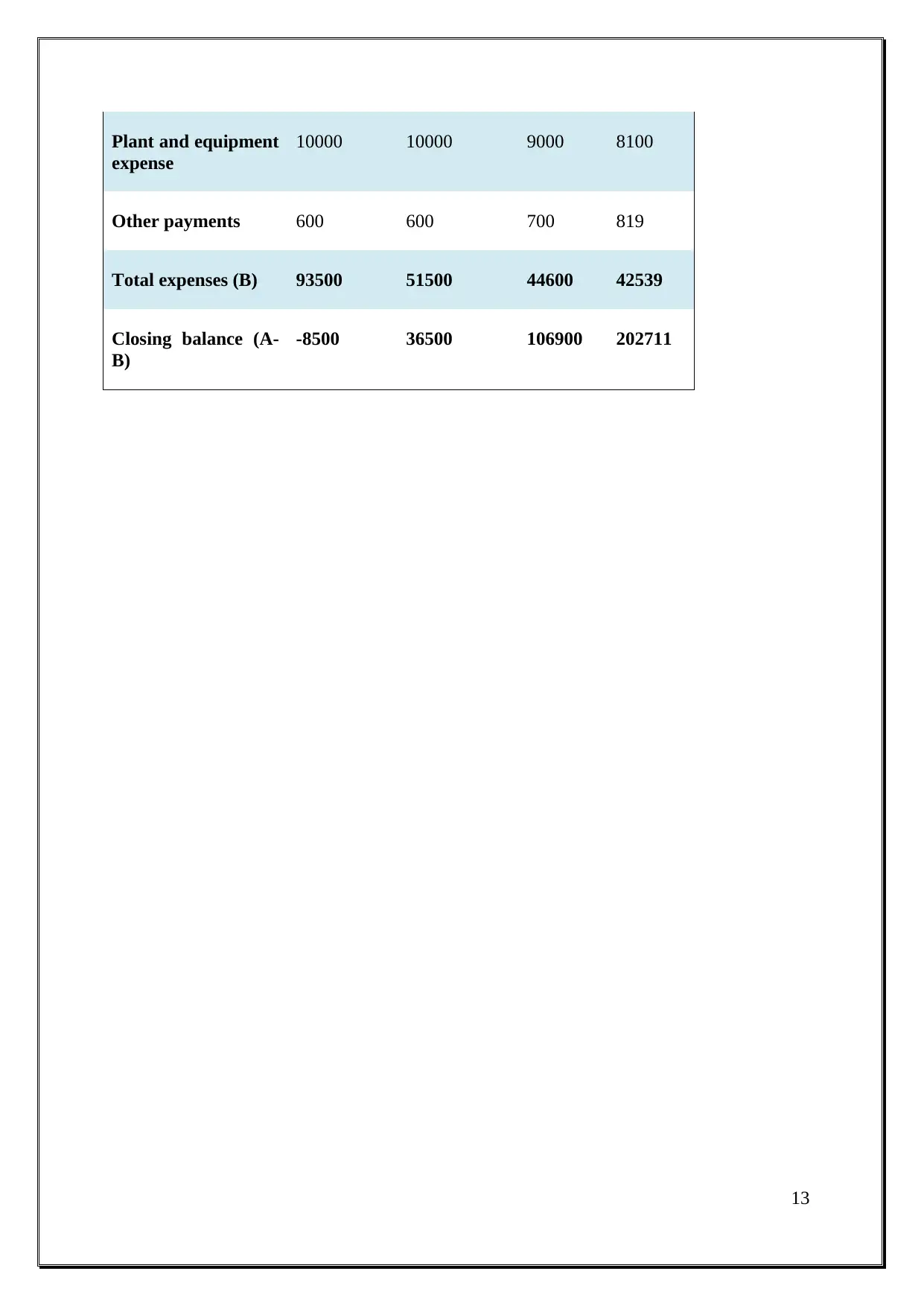
Plant and equipment
expense
10000 10000 9000 8100
Other payments 600 600 700 819
Total expenses (B) 93500 51500 44600 42539
Closing balance (A-
B)
-8500 36500 106900 202711
13
expense
10000 10000 9000 8100
Other payments 600 600 700 819
Total expenses (B) 93500 51500 44600 42539
Closing balance (A-
B)
-8500 36500 106900 202711
13
Paraphrase This Document
Need a fresh take? Get an instant paraphrase of this document with our AI Paraphraser
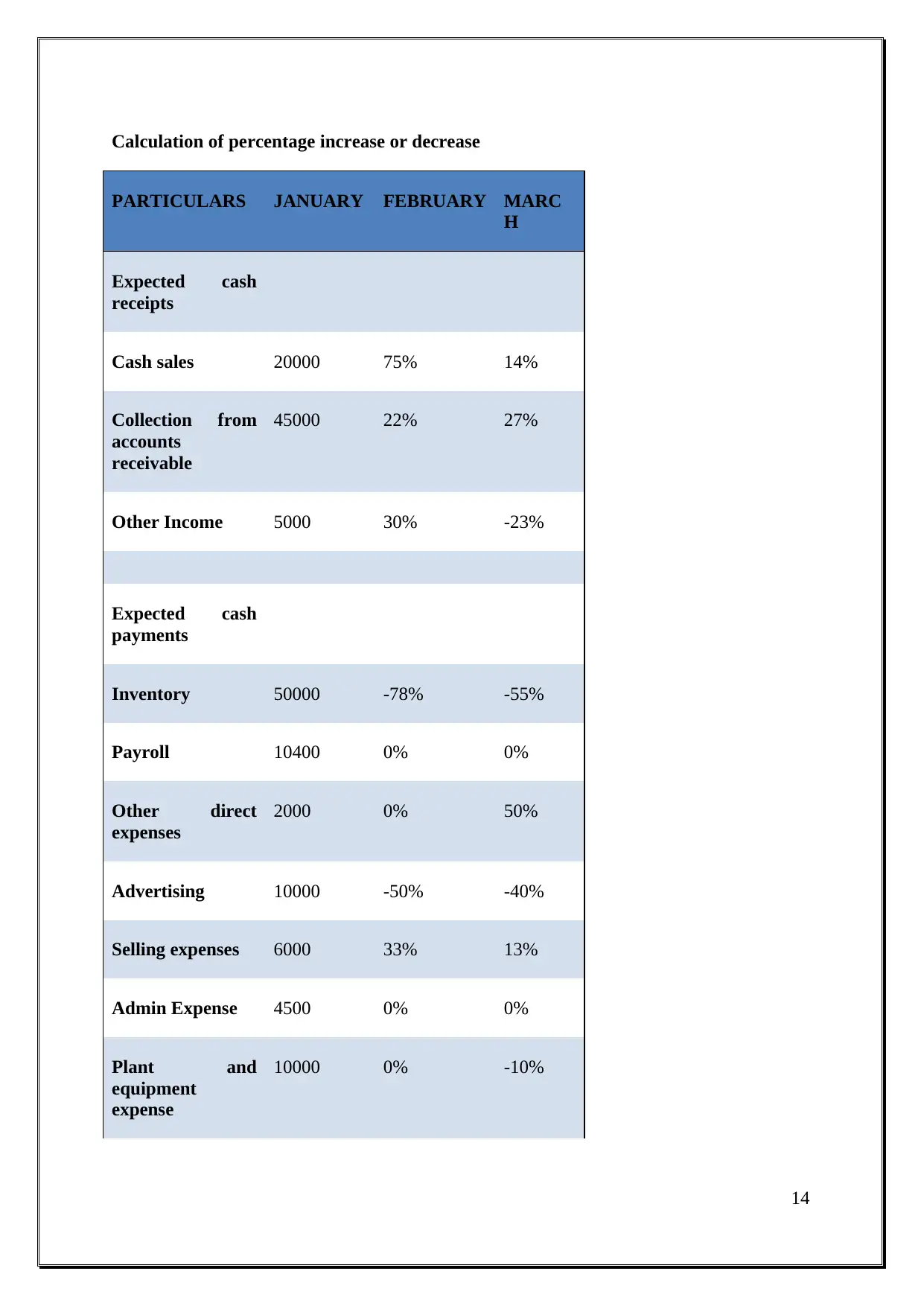
Calculation of percentage increase or decrease
PARTICULARS JANUARY FEBRUARY MARC
H
Expected cash
receipts
Cash sales 20000 75% 14%
Collection from
accounts
receivable
45000 22% 27%
Other Income 5000 30% -23%
Expected cash
payments
Inventory 50000 -78% -55%
Payroll 10400 0% 0%
Other direct
expenses
2000 0% 50%
Advertising 10000 -50% -40%
Selling expenses 6000 33% 13%
Admin Expense 4500 0% 0%
Plant and
equipment
expense
10000 0% -10%
14
PARTICULARS JANUARY FEBRUARY MARC
H
Expected cash
receipts
Cash sales 20000 75% 14%
Collection from
accounts
receivable
45000 22% 27%
Other Income 5000 30% -23%
Expected cash
payments
Inventory 50000 -78% -55%
Payroll 10400 0% 0%
Other direct
expenses
2000 0% 50%
Advertising 10000 -50% -40%
Selling expenses 6000 33% 13%
Admin Expense 4500 0% 0%
Plant and
equipment
expense
10000 0% -10%
14
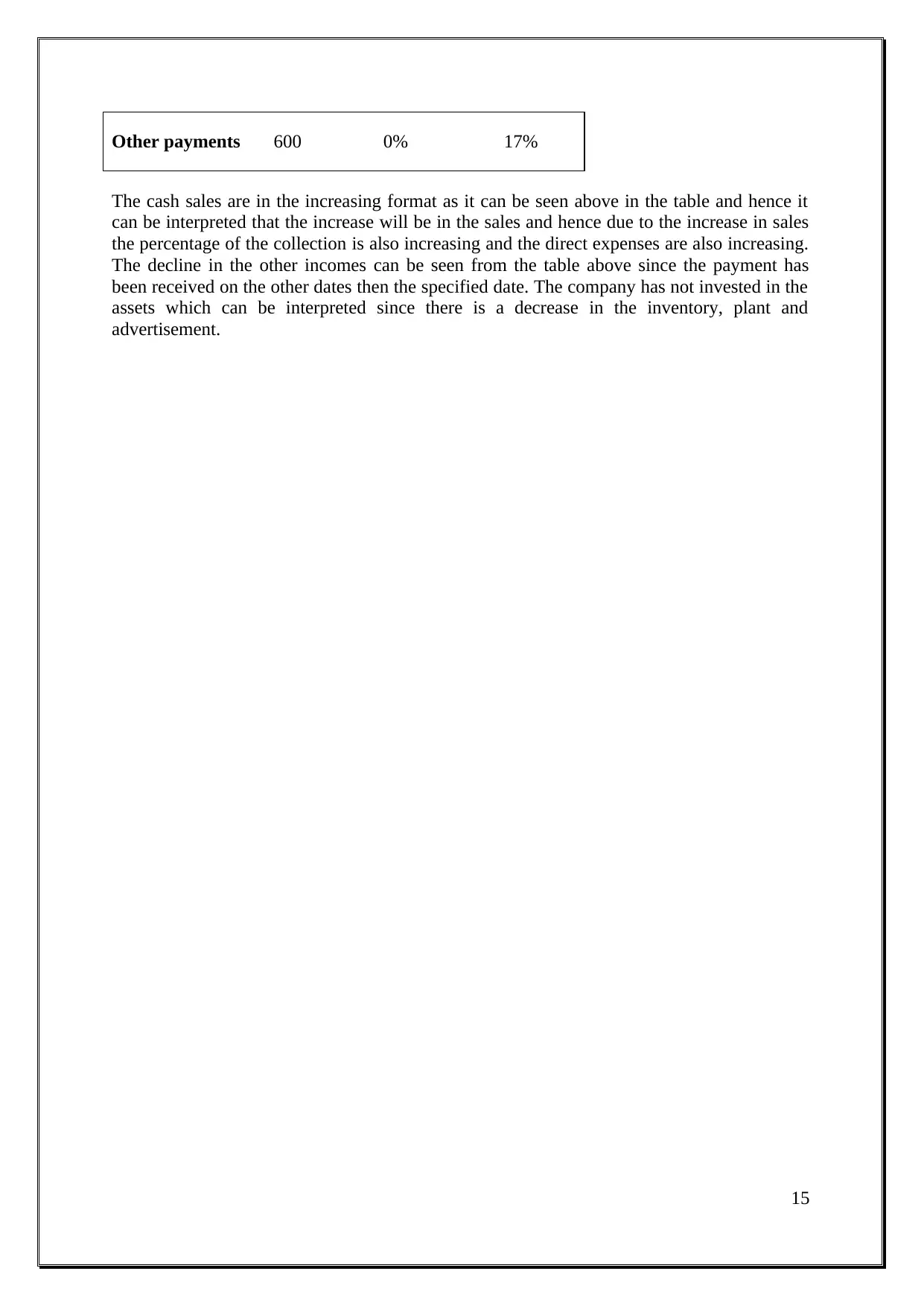
Other payments 600 0% 17%
The cash sales are in the increasing format as it can be seen above in the table and hence it
can be interpreted that the increase will be in the sales and hence due to the increase in sales
the percentage of the collection is also increasing and the direct expenses are also increasing.
The decline in the other incomes can be seen from the table above since the payment has
been received on the other dates then the specified date. The company has not invested in the
assets which can be interpreted since there is a decrease in the inventory, plant and
advertisement.
15
The cash sales are in the increasing format as it can be seen above in the table and hence it
can be interpreted that the increase will be in the sales and hence due to the increase in sales
the percentage of the collection is also increasing and the direct expenses are also increasing.
The decline in the other incomes can be seen from the table above since the payment has
been received on the other dates then the specified date. The company has not invested in the
assets which can be interpreted since there is a decrease in the inventory, plant and
advertisement.
15
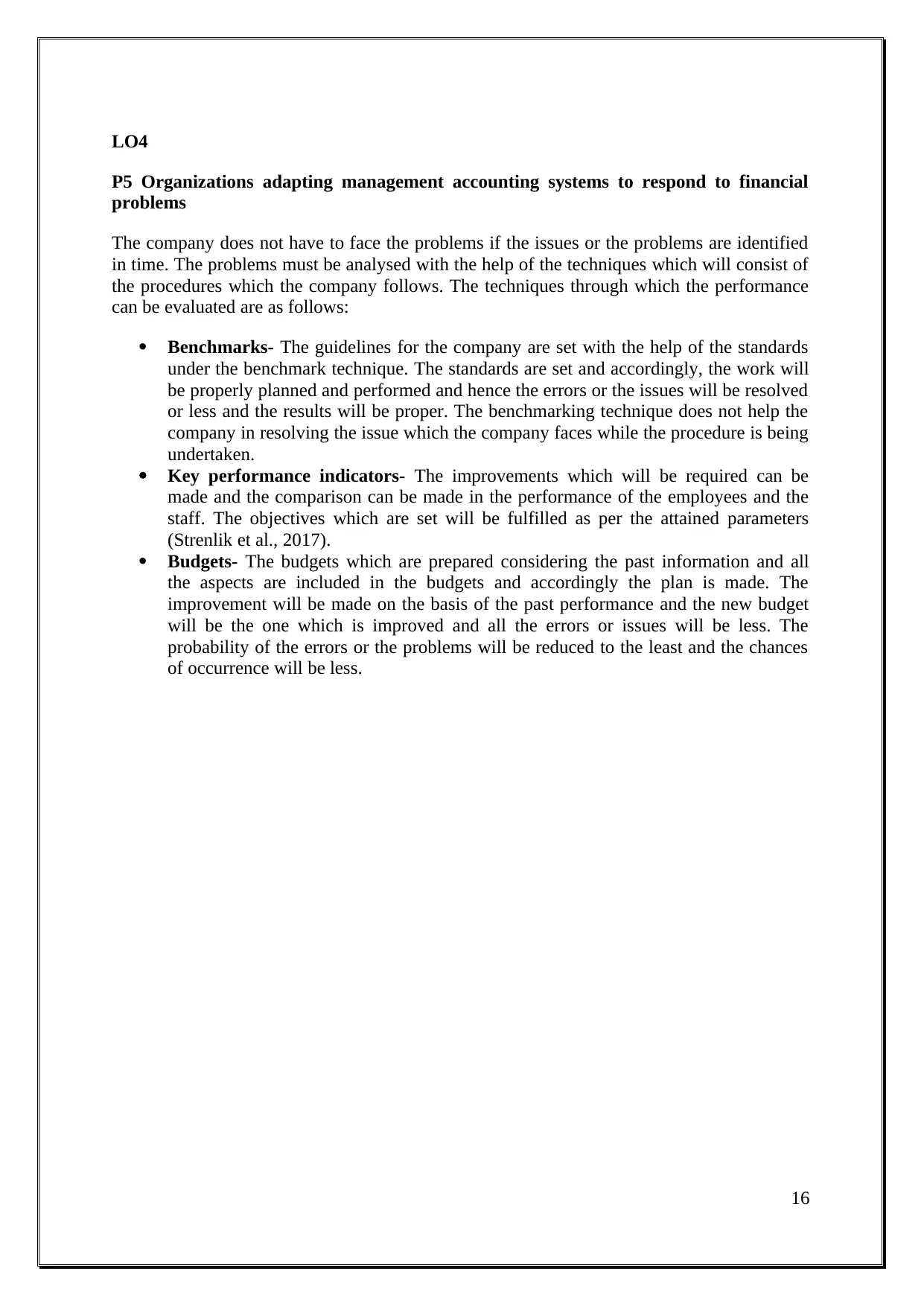
LO4
P5 Organizations adapting management accounting systems to respond to financial
problems
The company does not have to face the problems if the issues or the problems are identified
in time. The problems must be analysed with the help of the techniques which will consist of
the procedures which the company follows. The techniques through which the performance
can be evaluated are as follows:
Benchmarks- The guidelines for the company are set with the help of the standards
under the benchmark technique. The standards are set and accordingly, the work will
be properly planned and performed and hence the errors or the issues will be resolved
or less and the results will be proper. The benchmarking technique does not help the
company in resolving the issue which the company faces while the procedure is being
undertaken.
Key performance indicators- The improvements which will be required can be
made and the comparison can be made in the performance of the employees and the
staff. The objectives which are set will be fulfilled as per the attained parameters
(Strenlik et al., 2017).
Budgets- The budgets which are prepared considering the past information and all
the aspects are included in the budgets and accordingly the plan is made. The
improvement will be made on the basis of the past performance and the new budget
will be the one which is improved and all the errors or issues will be less. The
probability of the errors or the problems will be reduced to the least and the chances
of occurrence will be less.
16
P5 Organizations adapting management accounting systems to respond to financial
problems
The company does not have to face the problems if the issues or the problems are identified
in time. The problems must be analysed with the help of the techniques which will consist of
the procedures which the company follows. The techniques through which the performance
can be evaluated are as follows:
Benchmarks- The guidelines for the company are set with the help of the standards
under the benchmark technique. The standards are set and accordingly, the work will
be properly planned and performed and hence the errors or the issues will be resolved
or less and the results will be proper. The benchmarking technique does not help the
company in resolving the issue which the company faces while the procedure is being
undertaken.
Key performance indicators- The improvements which will be required can be
made and the comparison can be made in the performance of the employees and the
staff. The objectives which are set will be fulfilled as per the attained parameters
(Strenlik et al., 2017).
Budgets- The budgets which are prepared considering the past information and all
the aspects are included in the budgets and accordingly the plan is made. The
improvement will be made on the basis of the past performance and the new budget
will be the one which is improved and all the errors or issues will be less. The
probability of the errors or the problems will be reduced to the least and the chances
of occurrence will be less.
16
Secure Best Marks with AI Grader
Need help grading? Try our AI Grader for instant feedback on your assignments.
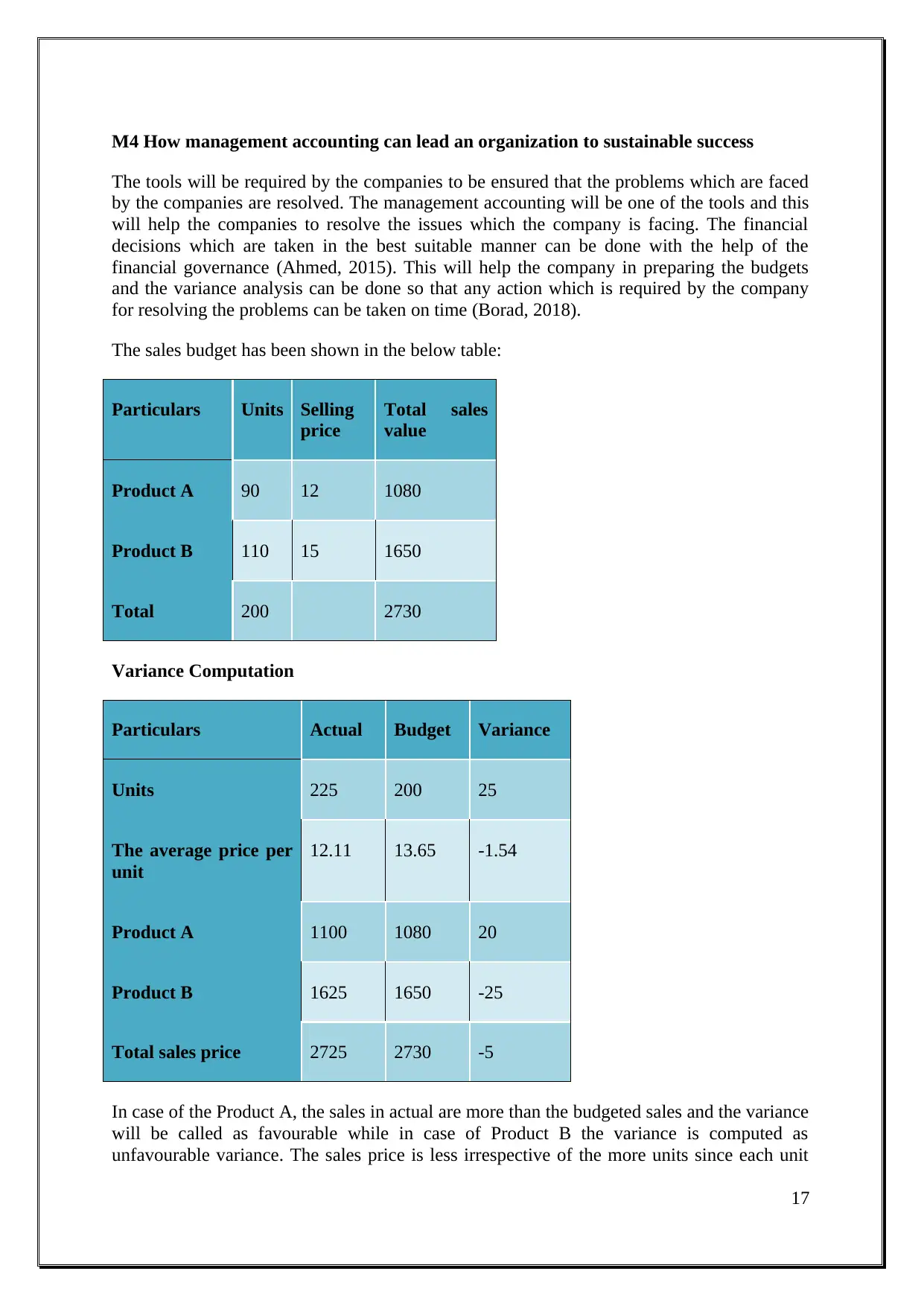
M4 How management accounting can lead an organization to sustainable success
The tools will be required by the companies to be ensured that the problems which are faced
by the companies are resolved. The management accounting will be one of the tools and this
will help the companies to resolve the issues which the company is facing. The financial
decisions which are taken in the best suitable manner can be done with the help of the
financial governance (Ahmed, 2015). This will help the company in preparing the budgets
and the variance analysis can be done so that any action which is required by the company
for resolving the problems can be taken on time (Borad, 2018).
The sales budget has been shown in the below table:
Particulars Units Selling
price
Total sales
value
Product A 90 12 1080
Product B 110 15 1650
Total 200 2730
Variance Computation
Particulars Actual Budget Variance
Units 225 200 25
The average price per
unit
12.11 13.65 -1.54
Product A 1100 1080 20
Product B 1625 1650 -25
Total sales price 2725 2730 -5
In case of the Product A, the sales in actual are more than the budgeted sales and the variance
will be called as favourable while in case of Product B the variance is computed as
unfavourable variance. The sales price is less irrespective of the more units since each unit
17
The tools will be required by the companies to be ensured that the problems which are faced
by the companies are resolved. The management accounting will be one of the tools and this
will help the companies to resolve the issues which the company is facing. The financial
decisions which are taken in the best suitable manner can be done with the help of the
financial governance (Ahmed, 2015). This will help the company in preparing the budgets
and the variance analysis can be done so that any action which is required by the company
for resolving the problems can be taken on time (Borad, 2018).
The sales budget has been shown in the below table:
Particulars Units Selling
price
Total sales
value
Product A 90 12 1080
Product B 110 15 1650
Total 200 2730
Variance Computation
Particulars Actual Budget Variance
Units 225 200 25
The average price per
unit
12.11 13.65 -1.54
Product A 1100 1080 20
Product B 1625 1650 -25
Total sales price 2725 2730 -5
In case of the Product A, the sales in actual are more than the budgeted sales and the variance
will be called as favourable while in case of Product B the variance is computed as
unfavourable variance. The sales price is less irrespective of the more units since each unit
17
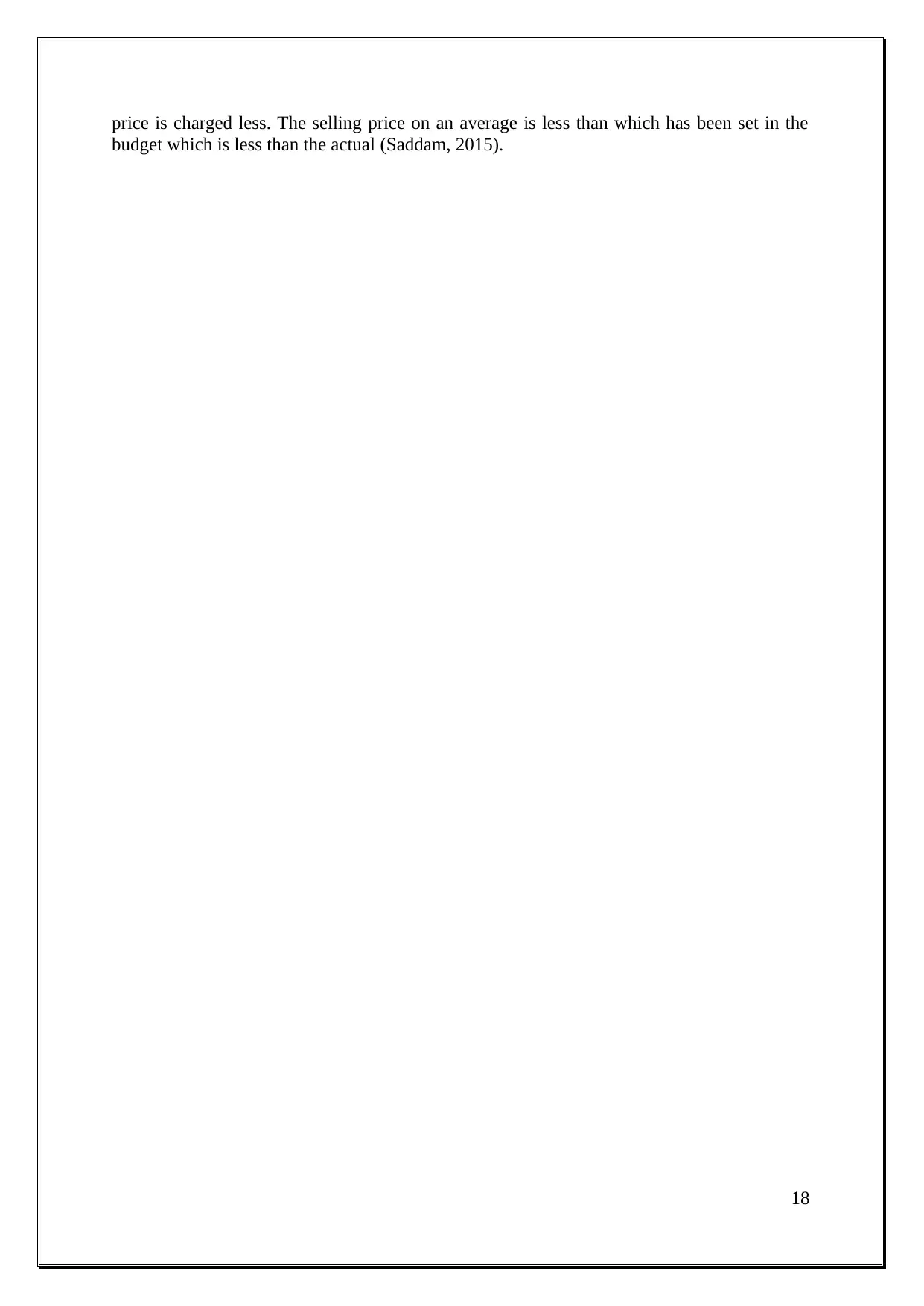
price is charged less. The selling price on an average is less than which has been set in the
budget which is less than the actual (Saddam, 2015).
18
budget which is less than the actual (Saddam, 2015).
18
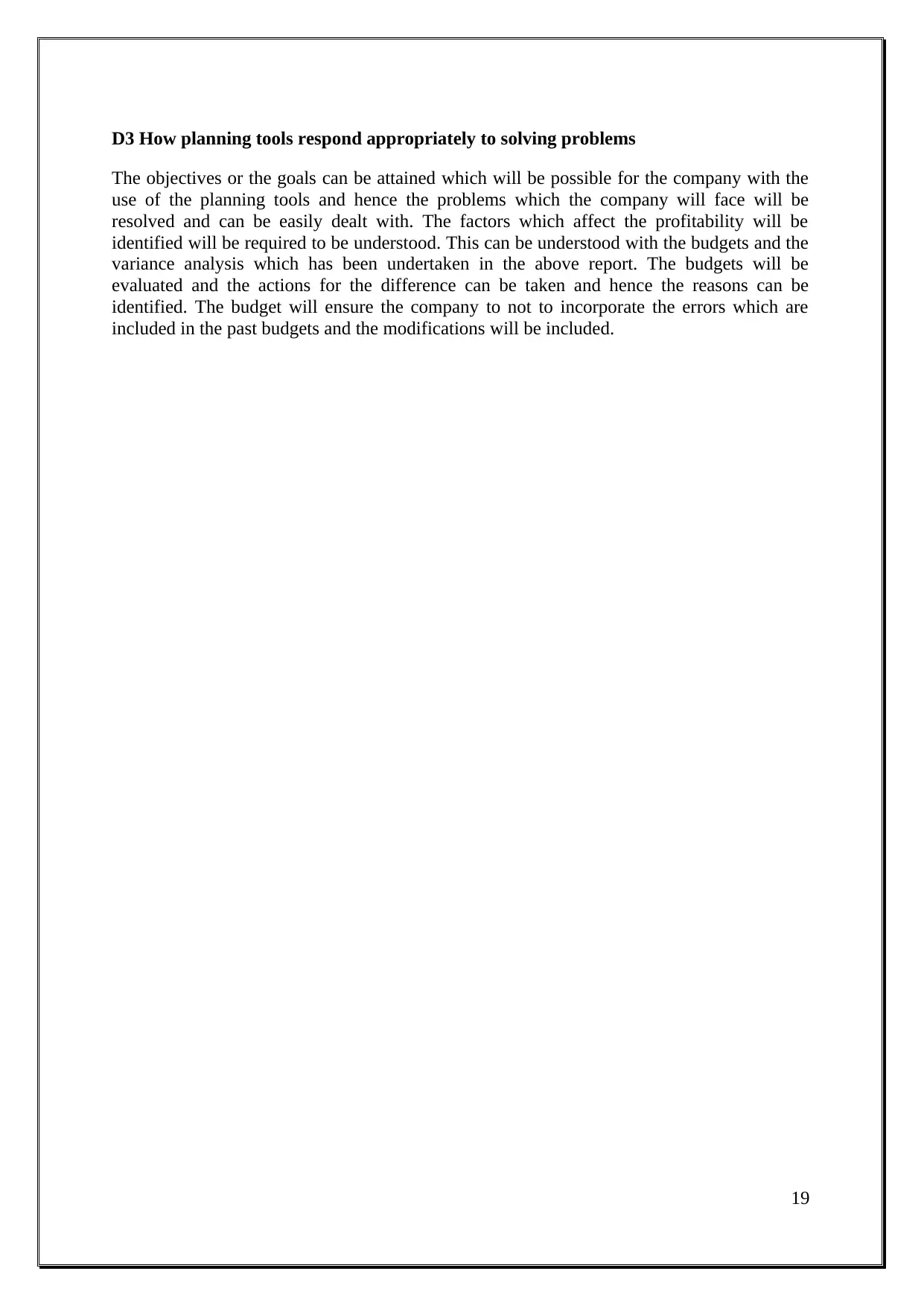
D3 How planning tools respond appropriately to solving problems
The objectives or the goals can be attained which will be possible for the company with the
use of the planning tools and hence the problems which the company will face will be
resolved and can be easily dealt with. The factors which affect the profitability will be
identified will be required to be understood. This can be understood with the budgets and the
variance analysis which has been undertaken in the above report. The budgets will be
evaluated and the actions for the difference can be taken and hence the reasons can be
identified. The budget will ensure the company to not to incorporate the errors which are
included in the past budgets and the modifications will be included.
19
The objectives or the goals can be attained which will be possible for the company with the
use of the planning tools and hence the problems which the company will face will be
resolved and can be easily dealt with. The factors which affect the profitability will be
identified will be required to be understood. This can be understood with the budgets and the
variance analysis which has been undertaken in the above report. The budgets will be
evaluated and the actions for the difference can be taken and hence the reasons can be
identified. The budget will ensure the company to not to incorporate the errors which are
included in the past budgets and the modifications will be included.
19
Paraphrase This Document
Need a fresh take? Get an instant paraphrase of this document with our AI Paraphraser
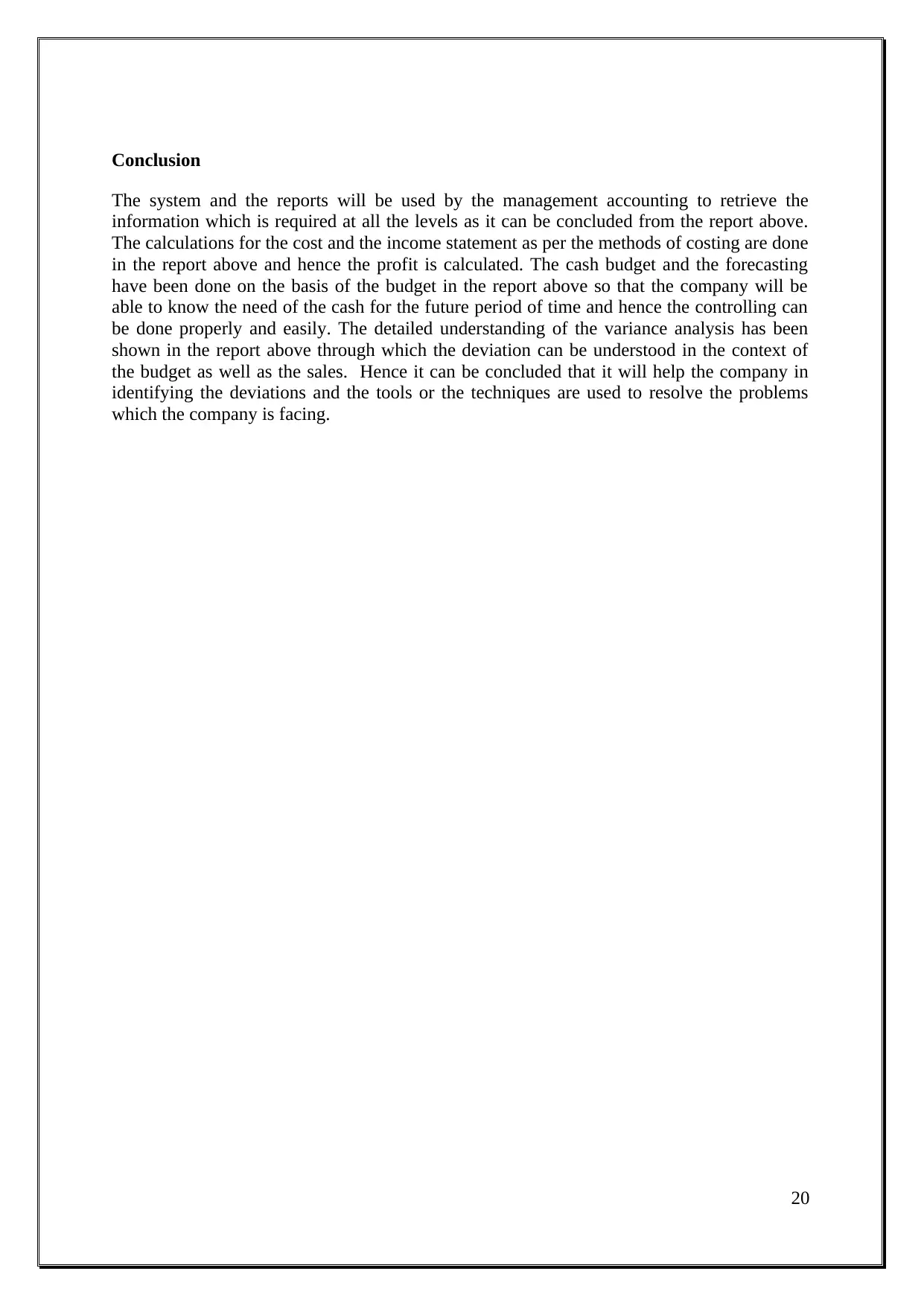
Conclusion
The system and the reports will be used by the management accounting to retrieve the
information which is required at all the levels as it can be concluded from the report above.
The calculations for the cost and the income statement as per the methods of costing are done
in the report above and hence the profit is calculated. The cash budget and the forecasting
have been done on the basis of the budget in the report above so that the company will be
able to know the need of the cash for the future period of time and hence the controlling can
be done properly and easily. The detailed understanding of the variance analysis has been
shown in the report above through which the deviation can be understood in the context of
the budget as well as the sales. Hence it can be concluded that it will help the company in
identifying the deviations and the tools or the techniques are used to resolve the problems
which the company is facing.
20
The system and the reports will be used by the management accounting to retrieve the
information which is required at all the levels as it can be concluded from the report above.
The calculations for the cost and the income statement as per the methods of costing are done
in the report above and hence the profit is calculated. The cash budget and the forecasting
have been done on the basis of the budget in the report above so that the company will be
able to know the need of the cash for the future period of time and hence the controlling can
be done properly and easily. The detailed understanding of the variance analysis has been
shown in the report above through which the deviation can be understood in the context of
the budget as well as the sales. Hence it can be concluded that it will help the company in
identifying the deviations and the tools or the techniques are used to resolve the problems
which the company is facing.
20
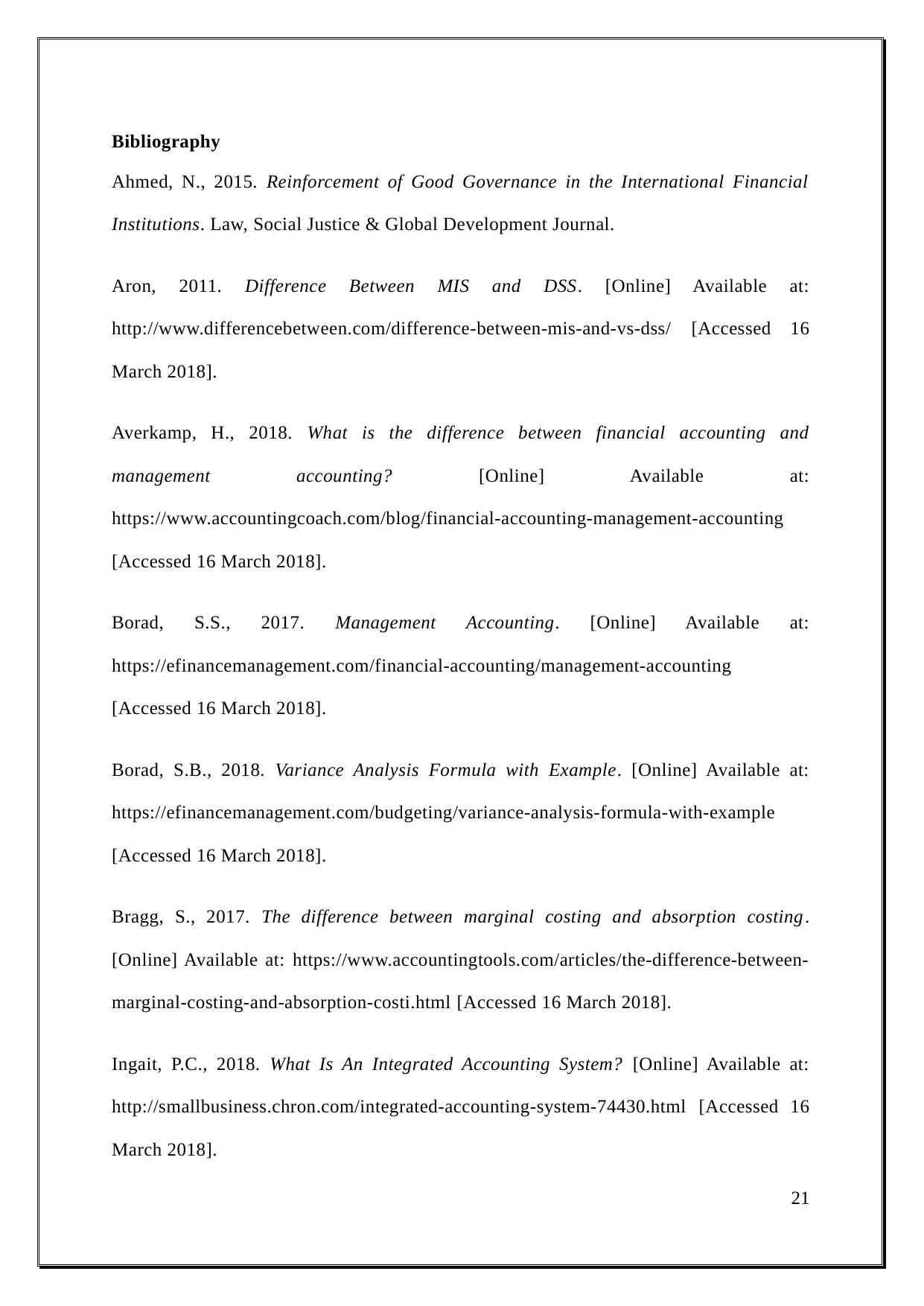
Bibliography
Ahmed, N., 2015. Reinforcement of Good Governance in the International Financial
Institutions. Law, Social Justice & Global Development Journal.
Aron, 2011. Difference Between MIS and DSS. [Online] Available at:
http://www.differencebetween.com/difference-between-mis-and-vs-dss/ [Accessed 16
March 2018].
Averkamp, H., 2018. What is the difference between financial accounting and
management accounting? [Online] Available at:
https://www.accountingcoach.com/blog/financial-accounting-management-accounting
[Accessed 16 March 2018].
Borad, S.S., 2017. Management Accounting. [Online] Available at:
https://efinancemanagement.com/financial-accounting/management-accounting
[Accessed 16 March 2018].
Borad, S.B., 2018. Variance Analysis Formula with Example. [Online] Available at:
https://efinancemanagement.com/budgeting/variance-analysis-formula-with-example
[Accessed 16 March 2018].
Bragg, S., 2017. The difference between marginal costing and absorption costing.
[Online] Available at: https://www.accountingtools.com/articles/the-difference-between-
marginal-costing-and-absorption-costi.html [Accessed 16 March 2018].
Ingait, P.C., 2018. What Is An Integrated Accounting System? [Online] Available at:
http://smallbusiness.chron.com/integrated-accounting-system-74430.html [Accessed 16
March 2018].
21
Ahmed, N., 2015. Reinforcement of Good Governance in the International Financial
Institutions. Law, Social Justice & Global Development Journal.
Aron, 2011. Difference Between MIS and DSS. [Online] Available at:
http://www.differencebetween.com/difference-between-mis-and-vs-dss/ [Accessed 16
March 2018].
Averkamp, H., 2018. What is the difference between financial accounting and
management accounting? [Online] Available at:
https://www.accountingcoach.com/blog/financial-accounting-management-accounting
[Accessed 16 March 2018].
Borad, S.S., 2017. Management Accounting. [Online] Available at:
https://efinancemanagement.com/financial-accounting/management-accounting
[Accessed 16 March 2018].
Borad, S.B., 2018. Variance Analysis Formula with Example. [Online] Available at:
https://efinancemanagement.com/budgeting/variance-analysis-formula-with-example
[Accessed 16 March 2018].
Bragg, S., 2017. The difference between marginal costing and absorption costing.
[Online] Available at: https://www.accountingtools.com/articles/the-difference-between-
marginal-costing-and-absorption-costi.html [Accessed 16 March 2018].
Ingait, P.C., 2018. What Is An Integrated Accounting System? [Online] Available at:
http://smallbusiness.chron.com/integrated-accounting-system-74430.html [Accessed 16
March 2018].
21
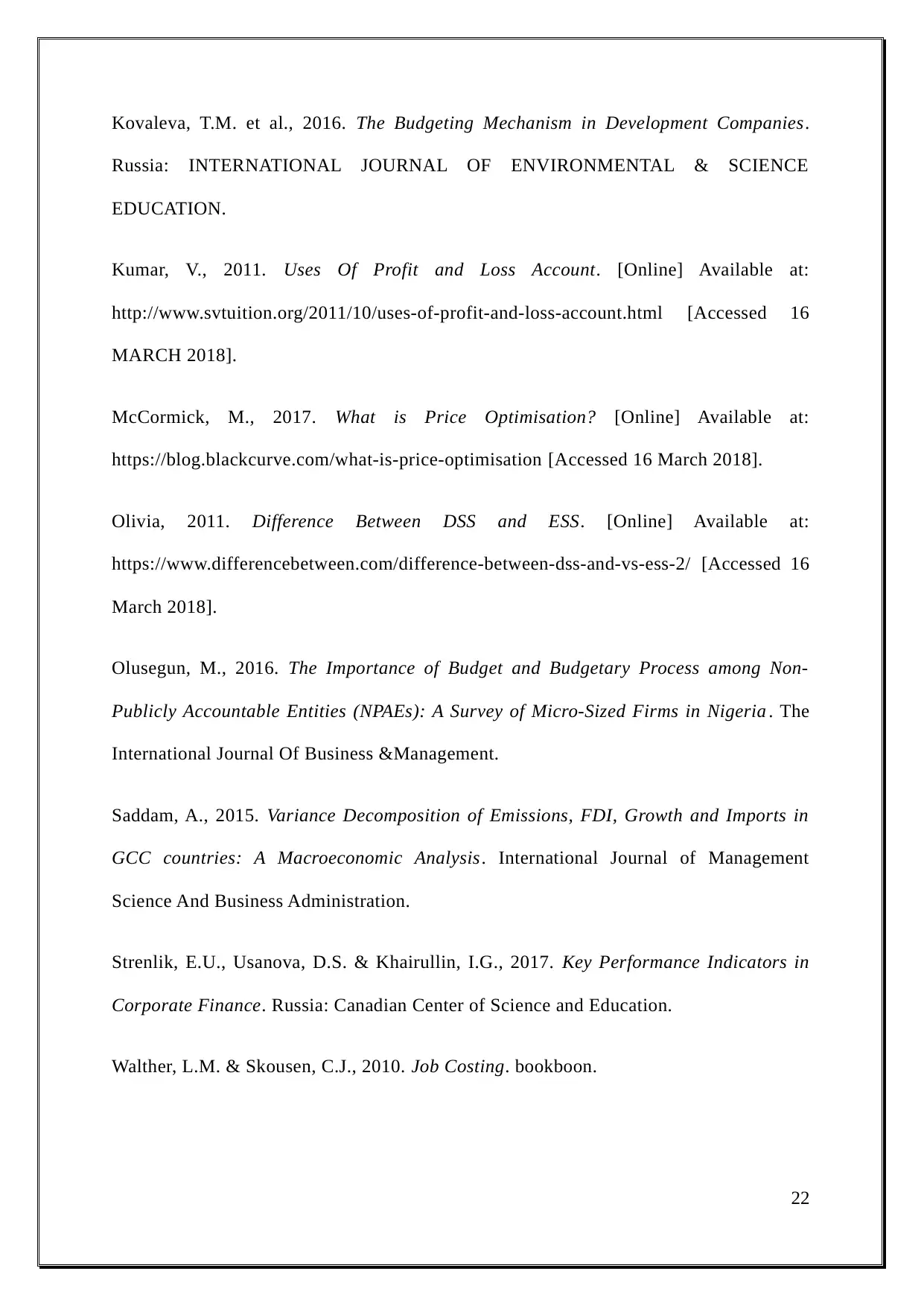
Kovaleva, T.M. et al., 2016. The Budgeting Mechanism in Development Companies.
Russia: INTERNATIONAL JOURNAL OF ENVIRONMENTAL & SCIENCE
EDUCATION.
Kumar, V., 2011. Uses Of Profit and Loss Account. [Online] Available at:
http://www.svtuition.org/2011/10/uses-of-profit-and-loss-account.html [Accessed 16
MARCH 2018].
McCormick, M., 2017. What is Price Optimisation? [Online] Available at:
https://blog.blackcurve.com/what-is-price-optimisation [Accessed 16 March 2018].
Olivia, 2011. Difference Between DSS and ESS. [Online] Available at:
https://www.differencebetween.com/difference-between-dss-and-vs-ess-2/ [Accessed 16
March 2018].
Olusegun, M., 2016. The Importance of Budget and Budgetary Process among Non-
Publicly Accountable Entities (NPAEs): A Survey of Micro-Sized Firms in Nigeria . The
International Journal Of Business &Management.
Saddam, A., 2015. Variance Decomposition of Emissions, FDI, Growth and Imports in
GCC countries: A Macroeconomic Analysis. International Journal of Management
Science And Business Administration.
Strenlik, E.U., Usanova, D.S. & Khairullin, I.G., 2017. Key Performance Indicators in
Corporate Finance. Russia: Canadian Center of Science and Education.
Walther, L.M. & Skousen, C.J., 2010. Job Costing. bookboon.
22
Russia: INTERNATIONAL JOURNAL OF ENVIRONMENTAL & SCIENCE
EDUCATION.
Kumar, V., 2011. Uses Of Profit and Loss Account. [Online] Available at:
http://www.svtuition.org/2011/10/uses-of-profit-and-loss-account.html [Accessed 16
MARCH 2018].
McCormick, M., 2017. What is Price Optimisation? [Online] Available at:
https://blog.blackcurve.com/what-is-price-optimisation [Accessed 16 March 2018].
Olivia, 2011. Difference Between DSS and ESS. [Online] Available at:
https://www.differencebetween.com/difference-between-dss-and-vs-ess-2/ [Accessed 16
March 2018].
Olusegun, M., 2016. The Importance of Budget and Budgetary Process among Non-
Publicly Accountable Entities (NPAEs): A Survey of Micro-Sized Firms in Nigeria . The
International Journal Of Business &Management.
Saddam, A., 2015. Variance Decomposition of Emissions, FDI, Growth and Imports in
GCC countries: A Macroeconomic Analysis. International Journal of Management
Science And Business Administration.
Strenlik, E.U., Usanova, D.S. & Khairullin, I.G., 2017. Key Performance Indicators in
Corporate Finance. Russia: Canadian Center of Science and Education.
Walther, L.M. & Skousen, C.J., 2010. Job Costing. bookboon.
22
Secure Best Marks with AI Grader
Need help grading? Try our AI Grader for instant feedback on your assignments.
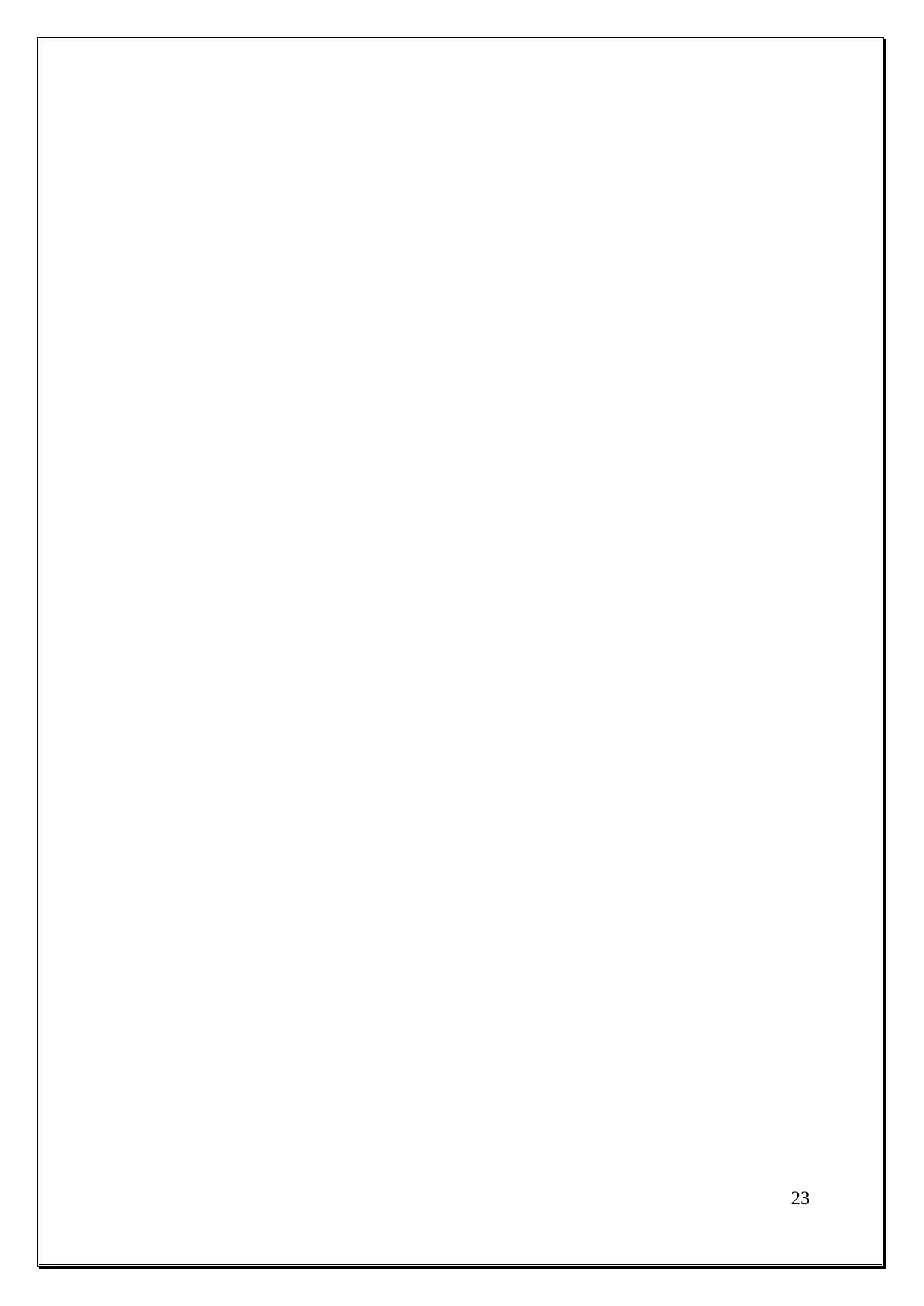
23
1 out of 23
Related Documents
Your All-in-One AI-Powered Toolkit for Academic Success.
+13062052269
info@desklib.com
Available 24*7 on WhatsApp / Email
![[object Object]](/_next/static/media/star-bottom.7253800d.svg)
Unlock your academic potential
© 2024 | Zucol Services PVT LTD | All rights reserved.





